Join More Than 50,000+ Subscribers and get latest camera news and rumors
NEW CAMERA VIDEOS ON YOUTUBE
|
By admin, on November 9th, 2024
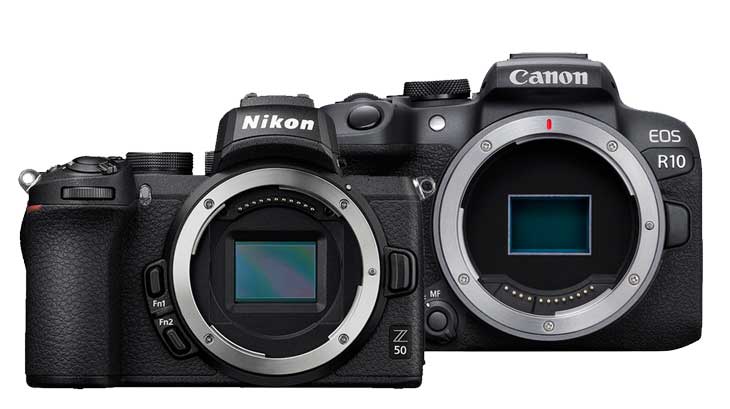
Let us compare the Nikon Z50 II with the Canon R10 camera. Let’s explore the main differences between these two cameras and find out which one is the best for photographers and which one is best for shooting videos. In the comparison table below, we have highlighted the differences in design, and we have created two separate tables dedicated to photography and videography features. So let’s find out the best camera between these two for your specific needs and budget.
1. Design Comparison
| Feature |
Nikon Z50 II |
Canon R10 |
| Body Dimensions |
5 x 3.8 x 2.6″ / 127 x 96.8 x 66.5 mm |
4.8 x 3.5 x 3.3″ / 122.5 x 87.8 x 83.4 mm |
| Weight |
495 g (Body Only) |
382.2 g (Body Only) |
| Lens Mount |
Nikon Z |
Canon RF |
| Display |
3.2″ Tilting Touchscreen LCD, 1,040,000 Dot |
3.0″ Free-Angle Tilting Touchscreen LCD, 1,040,000 Dot |
| EVF Type |
Built-In Electronic (OLED), 0.39″, 2,360,000 Dot – 1000 NITS Brightness |
Built-In Electronic (OLED), 2,360,000 Dot |
| Battery Type |
EN-EL25a or EN-EL25, approx. 230 shots |
LP-E17, approx. 430 shots |
| Ports |
USB-C Data & Power, Micro-HDMI, Mic & Headphone Jacks |
USB-C, Micro-HDMI, Mic Jack |
| Available Lenses |
Nikon Z DX and FX lenses |
Canon RF-S and RF lenses |
2. Photographic Feature Comparison
| Feature |
Nikon Z50 II |
Canon R10 |
Sensor Type
|
BSI CMOS |
FSI CMOS |
| Sensor Size |
23.5 x 15.7 mm (APS-C) |
22.3 x 14.9 mm (APS-C) |
| Effective Resolution |
20.9 Megapixel |
24.2 Megapixel |
| ISO Range (Photo) |
100 to 51,200 (Extended: 100 to 204,800) |
100 to 32,000 (Extended: 100 to 51,200) |
| Shutter Type |
Mechanical Focal Plane, Electronic Rolling |
Mechanical, Electronic Rolling |
| Shutter Speed (Mechanical) |
1/4000 to 900 sec |
1/4000 to 30 sec |
| Bulb Mode |
Yes |
Yes |
| Continuous Shooting (Mech) |
Up to 11 fps at 20.9 MP |
Up to 15 fps at 24.2 MP |
| Continuous Shooting (Elec) |
Up to 30 fps at 20.9 MP (JPEG) |
Up to 23 fps at 24.2 MP |
Pre-Capture Mode
|
1 Sec |
0.5 Sec |
| Autofocus Points |
231 (Phase & Contrast Detection) |
651 (Phase Detection Zones) |
| AF Sensitivity |
-9 to +19 EV |
-4 to +20 EV |
| AF Modes |
Continuous-Servo AF, Full-Time AF, Manual, Single-Servo AF |
Continuous-Servo AF, Manual, Single-Servo AF |
Weather sealed
|
Yes |
No |
Battery Life
|
250 Shots |
450 Shots |
3. Video Comparison
| Feature |
Nikon Z50 II |
Canon R10 |
| Sensor Type |
BSI CMOS |
FSI CMOS |
| Video Resolution & Frame Rates |
UHD 4K (30 fps) Uncropped |
UHD 4K (30 fps) Uncropped |
4k 60 FPS
|
1.5X Cropped |
1.5x Cropped |
Full HD Max Frame rate
|
120 FPS |
100 FPS |
Product showcase mode
|
Yes |
No |
| Video Stabilization |
Digital (Video Only) |
Digital (Video Only) |
| Internal Recording Codec |
H.264/H.265 (8/10-Bit) |
H.264 MP4 4:2:0 8-Bit, H.265 MP4 4:2:2 10-Bit |
| External Recording Codec |
HDMI 4K |
HDMI 1080p |
| HDR/LOG Support |
HDR-HLG, Nikon N-Log |
HDR-PQ |
Support RAW Video
|
Yes, N-Log available |
No, C-Log isn’t there |
| Recording Limit |
Up to 125 minutes |
Upto 120 Mins |
| Audio Recording |
Stereo, 24-Bit 48 kHz LPCM or 16-Bit AAC |
Stereo, 2-Channel AAC |
Conclusion Verdict
The Nikon Z50 II camera now has much-improved autofocus and also a low-light sensor, which helps to extract the maximum amount of detail possible in uncontrolled lighting environments or in any outdoor location. For wedding and event photography, we recommend you to go with Nikon Z50 II
Now, for sports and wildlife, it depends on which camera you like to buy since both are very capable. But again, due to the presence of a BSI CMOS sensor, the Z50 Mark II camera will perform better in uncontrolled lighting environments, specifically when you are using this camera for wildlife or bird photography. However, for sports events, you can take the Canon R10 with you when there is no big issue with light, as sports events generally happen during daylight. So, you may utilize the R10, and also, in sports events, you may require more reliable autofocus tracking, which is present in the Canon R10 alongside its slightly faster 15 fps mechanical shutter.
For day-to-day usage and street photography, I am going to recommend the Nikon Z50 Mark II camera. Due to the nature of its sensor and construction, the camera is able to capture clear shots and also has high low-light autofocus sensitivity compared to the R10. So more or less, for uncontrolled lighting environments of any type, the Nikon Z50 Mark II is more recommended. 165
Get a Nikon Z50 Mark II camera from the B&H Store | Amazon.com
Canon R10 – Camera body $879 [B&H Store] [Amazon.com] |
| Type of Photography/Video |
Recommended Camera |
| Wedding and Event Photography |
Nikon Z50 II
Due to its improved autofocus, low-light sensor, and availability of third-large amount party lenses , we recommend you to go with Nikon Z50 II |
| Wildlife and Bird Photography |
Nikon Z50 II
The BSI CMOS sensor in the Z50 II performs well in low-light and uncontrolled lighting, which is often required in wildlife photography. + You get AF sensitivity down to – 9 FV and upscaled 3d AI AF tracking. |
| Sports Photography (Daylight Events) |
Canon R10
Reliable autofocus tracking and slightly faster 15 fps mechanical shutter make the R10 a strong choice for sports events in daylight conditions. |
| Everyday Use and Street Photography |
Nikon Z50 II
Excellent low-light autofocus sensitivity and sensor design allow the Z50 II to capture clear shots in diverse lighting, making it versatile for daily use. |
| General Video Needs |
Canon R10 (for daylight, faster autofocus)
OR Nikon Z50 II (for low-light video) |
Nikon Z50 II Image Quality Test
Nikon Z30 / Zfc Image samples have been taken here since Nikon Z50 II and Zfc, both of them share the same sensor, so image quality is expected to remain exactly same as of the Nikon Z50 Mark II. Image credit dpreview.com
In the Image below we have compared the Nikon Z30 vs Canon R10 Images at ISO 25600, in RAW mode, as you can see the details are much preserved in Nikon Z50 II file
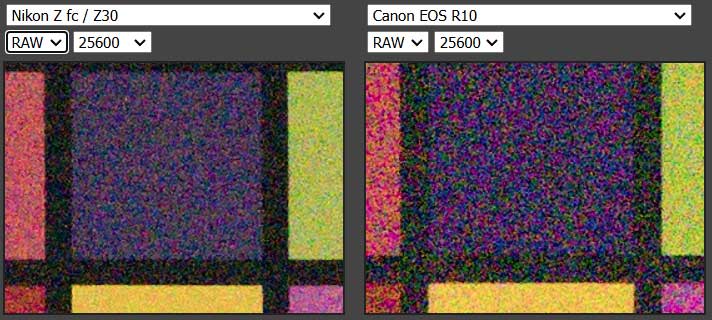
Next comparison Even in the JPEG comparison below you can see that Nikon is preserving more details compared to the Canon R10 FSI CMOS sensor.
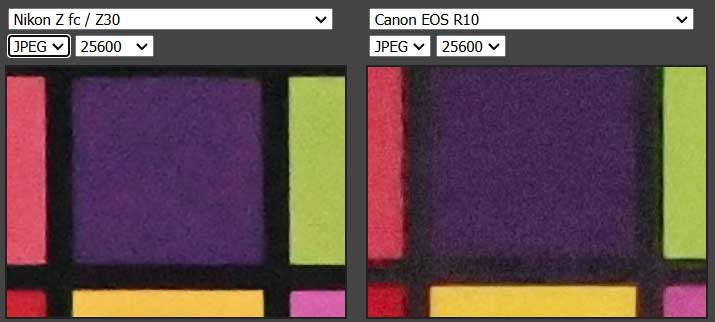
During the base ISO test we can see the letters in the Nikon Z50 II are more clearly visible than those of the Canon R10, despite having higher resolution Canon isn’t able to extract the amount of details they should at the base ISO range
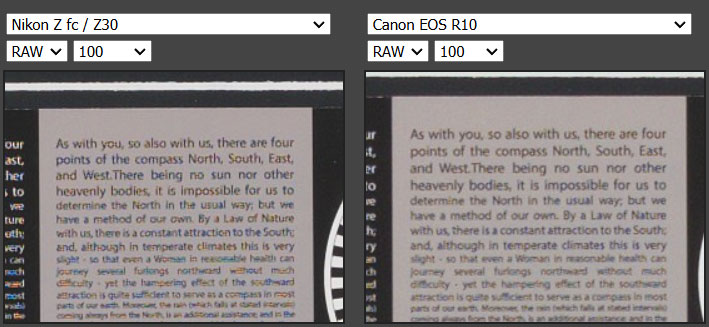
In the JPEG Mode, the performance of the Canon R10 Camera is much improved which may be due to JPEG filters the Nikon Z30 sample at base ISO losing a bit of details which was visible in the RAW Mode.
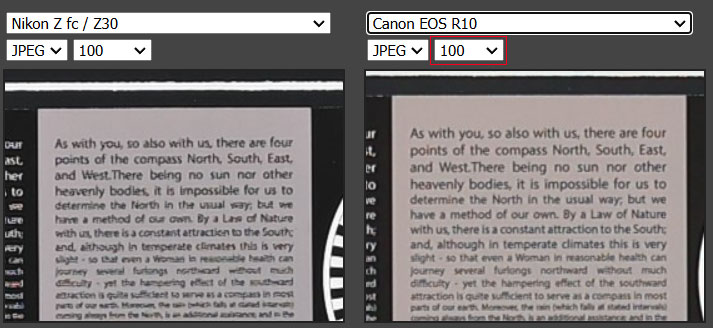
Verdict / Conclusion Image Quality
In terms of image quality, the Nikon Z50 II performs better than the Canon R10 at higher ISO settings, particularly when shooting in RAW mode. The Nikon Z50 II (or Z30) tends to capture more details at higher ISOs due to its 20MP sensor and lack of a low-pass filter, which helps to maintain fine textures.
However, at base ISO, when shooting in JPEG, the Canon R10 may show slightly more detail due to its higher 24MP resolution. But if you’re shooting in RAW at base ISO, the Nikon cameras can still provide a slightly clearer picture due to the low-pass-less design, which can enhance sharpness. Overall, for detail preservation, the Nikon Z50 II’s 20MP sensor has a slight edge, especially for those who prioritize high ISO performance and RAW shooting.
Support us – Use or affiliate link Amazon.com | B&H Store for the next purchase u make – it helps us
Follow us on our social pages FACEBOOK | TWITTER | INSTAGRAM to get live Camera News +
By admin, on February 19th, 2024
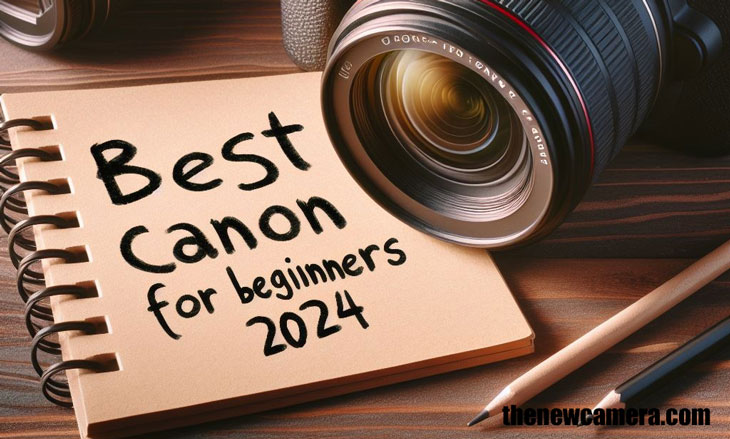
A lot of people are still buying the Canon T7 camera. Is it a good camera? Should you also buy a T7 and save a few bucks, or should you go towards the mirrorless lineup of Canon?
The biggest issue with DSLRs like the Canon T7 is the limited 9-point focusing mechanism. So if you are planning to buy a DSLR like the Canon T7, you should forget about the eye autofocus tracking that we have in mirrorless cameras. With the help of eye autofocus tracking, you can get properly well-focused images of the subject without any hassle.
But if you use the Canon T7, then you have to place the subject to fit inside the 9 centered autofocus points of the camera. Among one of the 9 points, you have to focus on a single point that falls on the same plane as the subject’s eye. I mean to say, mirrorless autofocusing mechanisms are now much faster compared to the DSLR face detect autofocus system. Since I have used both DSLRs and mirrorless cameras, I am sharing my personal experience with you.
| Feature |
Canon T7 |
Canon R100 |
| Sensor |
24-megapixel CMOS |
24.1-megapixel CMOS |
| Image Processor |
DIGIC 4+ |
DIGIC 8 |
| Subject Recognition |
Limited 9-point focusing mechanism |
Recognizes people (eyes, faces, and heads), animals (specifically dogs, cats, birds, and horses), or vehicles (motorsport cars and bikes, trains, and aircraft) |
| Continuous Shooting Speed |
Up to 3 frames per second |
Up to 6.5 frames per second |
| Display Screen |
Fixed, non-touch |
Fixed, non-touch |
| Video Recording |
Maximum continuous recording time for a single video of 29 minutes and 59 seconds | No Continous Video AutoFocus |
4K 25p or HD 120p | DPAF Fulltime AF | Eye AF tracking | 3D object Tracking |
| Weight |
Approx. 475 g |
Approx. 356 g |
| Image Quality |
Same as Canon R100 [Almost] |
Inferior to Canon R10 and R50 |
So the biggest downside of DSLRs like the Canon T7 is that they don’t have an algorithm for tracking, and hence the autofocus system is completely useless compared to the Canon mirrorless cameras we have.
The other biggest difference you will notice, apart from struggling with autofocus points, is the continuous autofocus feature in the video. DSLRs like the Canon T7 don’t have a continuous autofocus feature in video.
1. Best Canon Camera for Beginners Under $500
These are the limitations we have with the Canon entry-level DSLRs, and fortunately, the Canon R100 camera is in the same price range as the Canon T7 DSLR. So if you don’t have the budget to spend on Canon’s higher-end models, the R100 could be a good option.
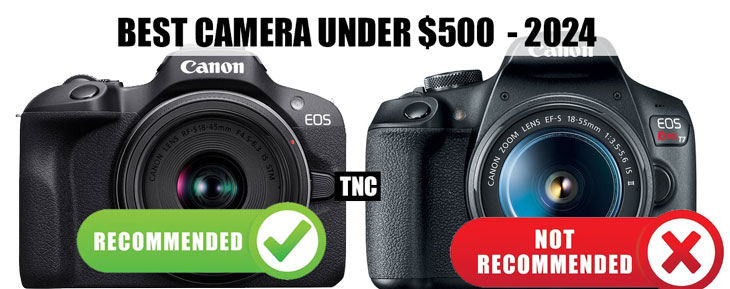
Recommendation: For Photographer, we highly recommend Canon R100 camera under $500 Range
Get The Best Canon R100 Camera – Amazon.com | B&H Store USA
2. Best Canon Camera for Beginners Under $700
Let’s compare the Canon R50 camera with the Canon R100 camera and clear up any confusion about which camera you should buy as a beginner.
| Feature |
Canon R50 |
Canon R100 |
| Sensor |
24-megapixel CMOS |
24.1-megapixel CMOS |
| Image Processor |
DIGIC X |
DIGIC 8 |
| Subject Recognition |
Recognizes people (eyes, faces, and heads), animals (specifically dogs, cats, birds, and horses), or vehicles (motorsport cars and bikes, trains, and aircraft) |
Recognizes faces and eyes, but for animal and car detection, you’ll need to step up to the more expensive EOS R50 |
| Continuous Shooting Speed |
Up to 15 frames per second |
Up to 6.5 frames per second |
| Display Screen |
Vari-angle | Fully Touch |
Fixed, non-touch |
| Video Recording |
4K 30p (6K oversampled) & FHD 120p |
4K 25p & HD 120p (No Oversampling) |
| Weight |
Approx. 328 g (375g with card and battery) |
Approx. 356 g |
| Image Quality |
Same as Canon R10 |
Inferior to Canon R10 and R50 |
We have some limitations here. The limitation is that we do not have Canon R50 camera samples. We have the R10 and R100 samples. The good thing is both of these cameras use the same sensor. Not only the same sensor, the Canon R50 and the Canon R10 cameras use the same image processor. Only the Canon R100 camera uses the older DIGIC 8 image processor, since the Canon R10 and R50 share the same image sensor and processor the image quality of the cameras will remain the same.

Looking at the samples, we can notice that there is a one-stop difference between the two cameras. So, we do have technical core differences between all these three cameras. The R100 camera uses the older image processor, has a 6.5 per second continuous shooting speed, and doesn’t have a touch display screen. That display screen is also fixed, so we have a lot of limitations with this camera. Associated with these limitations, we get inferior image quality in the Canon R100 camera compared to the other two on the list.
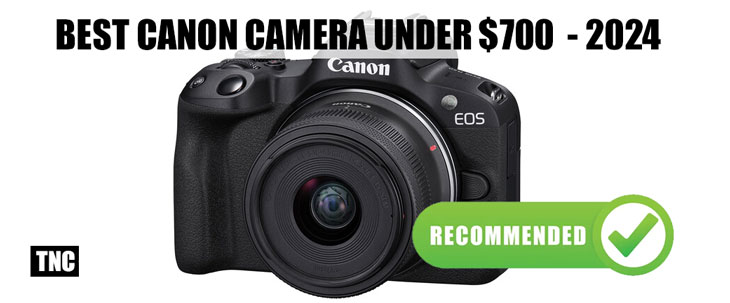
Best Canon Camera Under $700 Price Range Canon R50 – Amazon.com | B&H Store
So, for those who are looking to buy the Canon R100 camera, I would say that there is a very small price difference between the Canon R50. If you can manage to buy the R50 camera, you should at any cost. It’s highly recommended to you. Since you’re getting inferior core specifications along with the Canon R100 camera, you are also getting inferior image quality. So, steer clear of that.
3. Best Canon Camera for Beginners Under $1000
Let Us compare the Canon R50 and Canon R10, and find out the reason why should you buy the Canon R10 instead of Canon R50 if you have approx $1000 budget for your camera in 2024.
| eature |
Canon R10 |
Canon R50 |
| Sensor |
24MP APS-C CMOS |
24.2MP APS-C CMOS |
| Image Processor |
DIGIC X |
DIGIC X |
| Low Light Performance |
Almost same as Canon R50 |
|
| Mechanical Shutter Speed |
Up to 15 fps |
Up to 12 fps |
| Electronic Shutter Speed |
Up to 23 fps |
Up to 15 fps |
| Video Recording |
4K 30p full sensor & 4K 60p cropped |
4K 30p full sensor |
| Weight |
Approx. 429 g |
Approx. 375 g (lighter) |
| Image Quality |
Similar |
|
| Subject Recognition |
People (eyes, faces, heads), animals (dogs, cats, birds, horses), vehicles (motorsports cars/bikes, trains, aircraft) |
People (eyes, faces, heads) |
| Autofocus Points |
651 AF Zones | 4503 individually selectable AF points |
same as Canon R10 |
| Physical Dials/Buttons |
More dedicated dials and buttons for manual control [Joy stick on the rear side] |
Fewer physical controls, relies more on touchscreen |
| Battery Life |
CIPA rated 430 shots |
CIPA rated 390 shots |
| Headphone Jack |
Yes |
No |
Among all these three cameras, as I have said, if your budget allows, you should go with the Canon R50. But again, if you talk about the best of all these three, then without a doubt, the Canon R10 is superior.
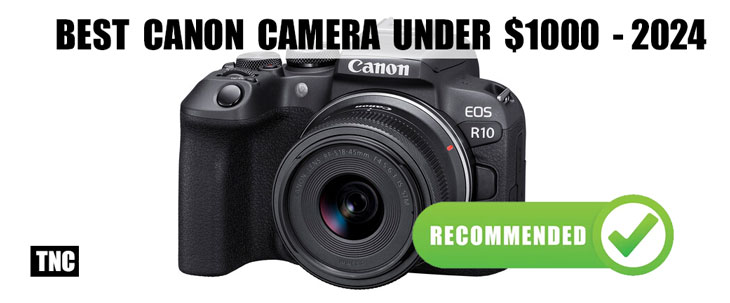
Buy Canon R10 Camera from Amazon.com | B&H Store
Why so? With this camera, you are getting a pre-shooting buffer, a feature that professionals will love to use. Other features include a 15 FPS mechanical shutter that will give you zero distortion while capturing images. The mechanical shutter speed of the R50 is limited to 12 frames per second. If we compare the electronic shutter speed in the Canon cameras, the R10 has a higher speed.
Other features include lens breathing correction, a better, higher resolution display screen, and the ability to record 4K videos at 60 frames per second with some crop.
* We have excluded the Canon M series cameras since they have been completely discontinued and even their Lenses are not usable on any mount | So in 2024 kindly don’t invest in the EOS M Series
Lets me know if you have any further questions
By admin, on January 3rd, 2024
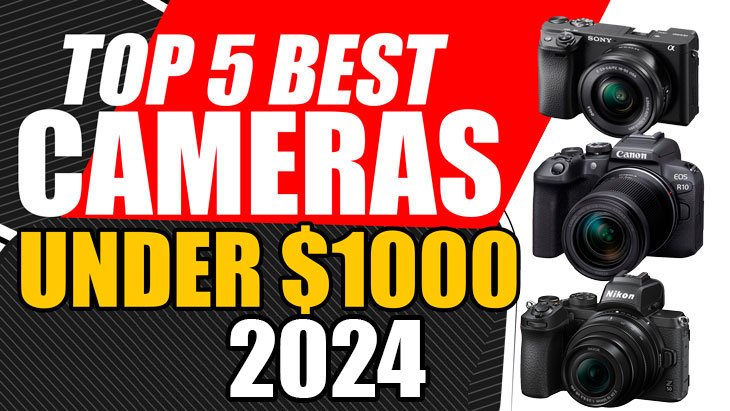
Take a look at the best mirrorless cameras of 2024, we have selected the best camera for your budget. Not only a camera for a specific area of interest we are recommending lenses also, without a proper lens u will never get a perfect output. So, always remember lenses are very important.
How to Select the Best Camera Under 1000 Dollars
Sensor Size
Image quality is a very important factor while selecting a camera. There are a lot of cameras with Micro Four Thirds format sensors, APS-C sensors, and even some full-frame sensor-based cameras present under the $1000 range.
However, one of the most important factors is not to buy a super outdated full-frame camera which is available for under $1000. If you buy a 5-year-old technology right now, then you will have very poor low-light performance with that particular full sensor. It’s highly recommended to buy the newest camera possible in the market so it will have the latest technology, and the best dynamic range possible. If you wish to buy a full-frame camera then of course there are options, but in that case, you have to care about the light situation when you are shooting, otherwise, you may have some issues with the older sensors. So mostly, we have selected some of the best available sensors, specifically those that are most updated and new for the buying guide.
Resolution
In limited sensor size, if the resolution of a camera sensor increases, at the same time the pixel per inch density increases, and hence the size of each pixel gets decreased. Buying a higher resolution camera, be prepared to have a good light setup. The higher resolution sensor will extract more details from a given scene but only if there is a presence of good light, otherwise, a lower resolution sensor will perform better compared to a sensor with high-density megapixels. So now you understand the balance, if you are working in a studio or controlled light environment you can buy a high-resolution camera. If you’re working in a low-light environment, you have to select a sensor with a lower MP count like Nikon Z50 or Z30.
Features
The features you get inside a camera depend upon the camera maker. Features include the ISO range of the camera, the continuous shooting speed capability, as well as the video quality of the camera. It depends on you, if you’re a sports photographer, you will mainly concentrate on the autofocus system of the camera as well as the continuous shooting speed. For those who are mostly inclined towards sports photography and want to have a fast shooting speed, they can have a Canon R10 camera which can shoot up to 15 frames per second with a mechanical shutter and up to 23 frames per second with an electronic shutter. And If you’re inclined towards videography under budget then you can have cameras like the Sony ZV-E10, one of the most capable cameras under $1000. You will save some bucks for having high-quality lenses and at the same time, if you want a camera that performs well, you can consider the Nikon Z30 and R50 cameras.
The selection of a camera depends upon your own set of requirements and the budget you have. If you are clear about your requirements, this guide will surely help you to get the perfect camera for your budget and your requirements.
Lenses
Finally, the lenses are the most important part of the camera. Without a perfect dedicated prime lens or a constant aperture-based zoom lens, you will have output from your camera similar to your smartphone. What I want to say is that if you’re planning to buy a camera with its kit lens, then for sure the output will disappoint you to some extent and you will feel the camera is capturing in the same manner as your smartphone captures. So it is highly recommended that if you’re planning to buy a mirrorless system camera of any brand, better to buy a camera body first and then decide the perfect lens for the camera. We have created several buying guides for each camera to have a perfect lens as per your requirement, so we are associating the lens guide too with each camera.
What are the Best Cameras in 2024?
|
Product |
Features |
Check Price |
|
Sony ZV-E10 |
- Best Vlogging Camera
- Budget-friendly
- Many Lenses available
|
 |
|
Nikon Z30 |
- #2 Option for Vloggers
- Excellent Low Light
- Budget-friendly
|
 |
|
Canon R10 |
- Best for Sports | Wildlife
- Also a Great Vlogging Tool
|
 |
|
Nikon Z50 |
- Low-light Beast
- For Wedding Photography
- For streets
|
 |
|
Sony A6400 |
- Best wedding Hybrid Camera
- Budget Wedding cinematography
|
 |
|
|
|
|
We have a new camera on our list, the Sony ZV-E10 Mark II. The Sony ZV-E10 Mark II is one of the best cameras available for content creators under the $1000 price range [Amazon.com | B&H Store] for the body only.
However, you will need to spend more on lenses; otherwise, the kit-less option is available at $1098 Price
Why should you spend more compared to the ZV-E10? The main advantage of the Sony ZV-E10 Mark II is that it has been recently announced by Sony and features 10-bit internal recording. With 10-bit internal recording, you are able to get the maximum dynamic range possible in this slot, which was not possible with the Sony ZV-E10 or any other camera. Even the Canon R10 does have a 10-bit recording option, but only in HDRPQ mode. So, the ZV-E10 Mark II has become the only camera in this place that offers 10-bit internal recording.
Other features include the ability to record 4K 60fps uncropped video. The Sony ZV-E10 Mark II is able to record 4K videos up to 60 frames per second without any crop. One of the best things about this camera is that it includes Product Showcase mode, Face Auto Exposure tracking priority mode, a dedicated internal microphone, a headphone port to monitor your audio, and in-camera image stabilization.
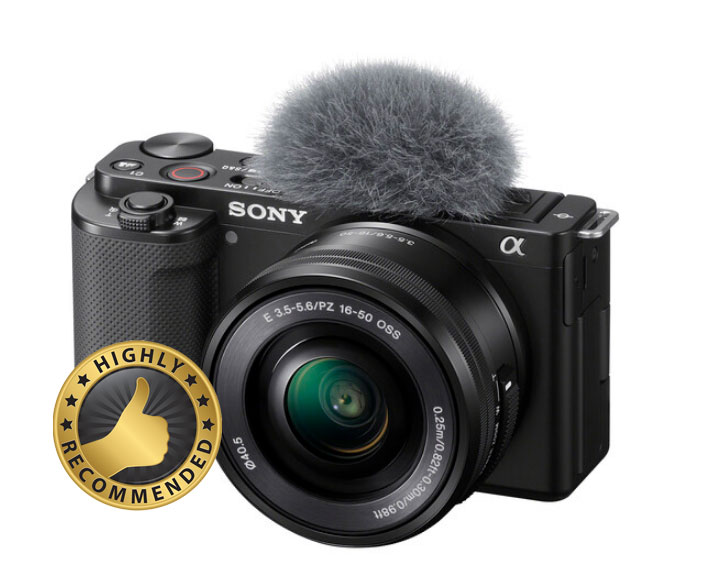
The best Camera right now is the Sony ZV-E10, the Sony ZV-E10 is even better than the Nikon Z30 since you have more range of available lenses to choose from, gyro-based Image Stabilization, as well as several features (3 capsule mics, product showcase mode, face exposure mode, and one-touch bokeh) for vloggers, the ZV-E10 camera makes vlogging easier.
Spend on some good Lenses – Best Lense for Sony ZV-E10 Camera
What people are saying after using ZV-E10 for more than a month
With this being my first camera, I chose an entry level option and this has turned out to be such an amazing upgrade from a cellular camera. Will definitely be buying more lenses for this camera! —–by matthew
The Sony ZV-E10 features a 24MP APS-C sensor, articulating selfie screen with touch capability, good quality oversampled and uncropped 4K/24p capture, headphone and microphone port, and a variety of add-on accessories to assist in video capture specifically aimed for bloggers or you can say a camera that’s really close to being a vlogger’s dream-camera, both in terms of price and feature set.
Sony ZV-E10 Pros and Cons
| Pros |
Cons |
- Compact size
- Articulating screen
- Great autofocus
- Supports add-on mic and headphone monitoring
- Works as a USB webcam
|
- Rolling shutter while panning
- In-camera charging slow for on-the-go use
|
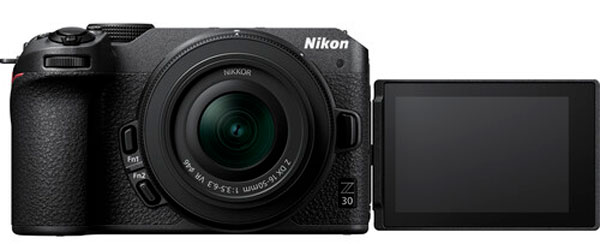
You can’t ignore the presence of the Nikon Z30, the camera uses the same 20 MP Excellent low-light sensor we have seen in cameras like Nikon Z50 and ZFC. If you are not in the mood to purchase the Sony ZV-E10 for some reason then the next best option is Nikon Z30, otherwise, always try to have the ZV-E10 first.
What people are saying after using ZV-E10 for more than a month
A simple camera that’s quite easy to use. The image quality is also quite nice. AF performance is top class
The Nikon Z30 is Nikon’s entry into vlogging world, the Z30 is a cut-down version of the Z50 model, with added vari-angle display screen, tally light, and 125-minute recording limit aimed at video content creators a cinematic video solution under budget.
Get Nikon Z30 from B&H Store | Amazon.com
Nikon Z30 Pros and Cons
| Pros |
Cons |
- Compact size
- Articulating screen
- Works as a USB webcam
|
- 28 min time limit on 4K to prevent overheating
- In-camera charging slow for on-the-go use
|
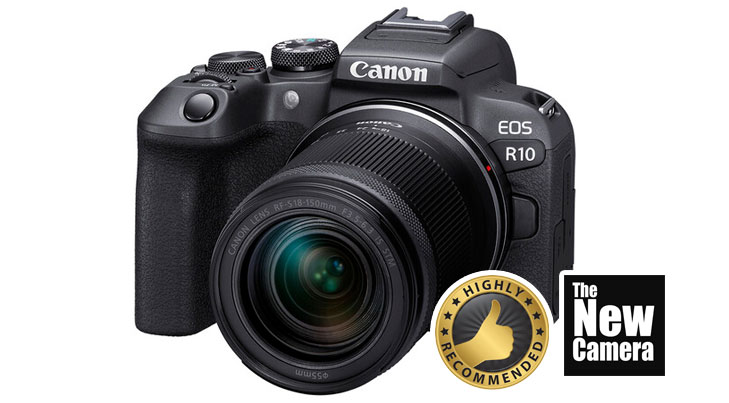
Canon R10 is the best camera for shooting sports or wildlife under a budget. Canon R3 uses the same AF Algo that’s being used in Canon R3, but due to hardware limitations (Sensor readout speed), the MAX burst speed is limited to 23FPS with full-time AF/AE support. The recommended budget lens for Wildlife and Sports is RF 100-400mm lens.
What people are saying after using Canon R10 for more than a month
I’m astonished that this relatively inexpensive camera has the same autofocus system found on Canon’s top of the line mirrorless cameras costing between five and six thousand dollars. This inclusion means that the chance of getting not just keeper images, but superb ones is much better than systems lacking such an advanced system. ……You can set the autofocus to track people, animals or vehicles for example. If set for animals, the autofocus is fast enough to track the eye of a bird in flight. The accuracy and speed of this camera have to be experienced to be appreciated. —- Paul
The only visible issue with the Canon APS-C system right now is a limited range of Lenses available for native RF Mount of cameras. Since Canon has a locked RF Mount and no third-party makers are allowed to make Canon Lenses.
Recommended for: Vlogs, Fashion, model portrait shoots, wildlife, and sports photography.
Canon R10 at B&H Store | Amazon.com
Canon R10 Pros and Cons
| Pros |
Cons |
- Compact and lightweight
- Impressive autofocus smarts
- Speedy burst mode
- Good value
- 4k 60p
|
- No in-body image stabilization
- Single card slot
- Locked RF-Mount
|
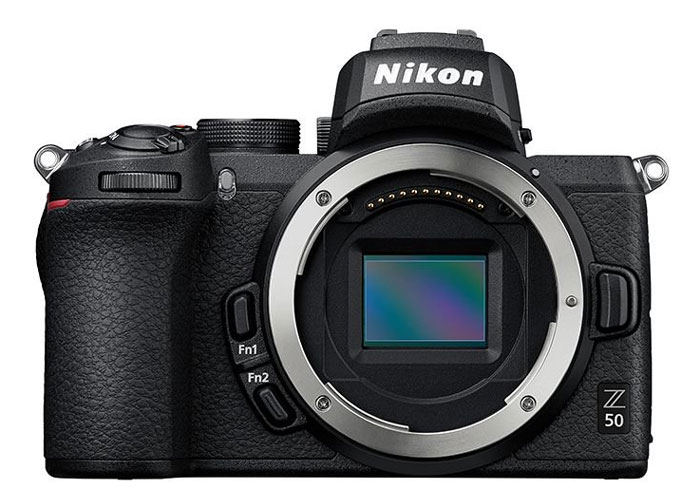
The Nikon Z50 is the first-generation Z-mount DX mirrorless camera, although with constant firmware updates, the camera is much improved compared to when it was announced.
Since the camera is made by a DSLR giant the ergonomics and user interface are generally very good, inside we have a modified D7500 sensor, a 20.9 MP DX Hybrid sensor with 209 Hybrid AF points, although the MAX shooting speed is limited to 11 FPS, the camera also has the ability to record high-quality 4K video at up to 30 FPS without any crop (Full HD slow motion at up to 120 FPS) and a compact, lightweight weather-sealed construction. A perfect camera for wedding & Event shooters as well as street shooters those who work with uncontrolled light environments.
What people are saying after using Nikon for more than a month
Surprisingly easy to use, feels good in-hand, and eye detect works great. For someone new to a ‘real camera’, this would be a great step into the advantages offered beyond the ubiquitous phone.
Really, about the only fault worth mentioning is the absence of in-camera image stabilization, but the in-lens IS does a great job in these kit lenses.—- Alan
The concerns – AF tracking of moving subjects is not as good as we see in Canon or Sony Cameras, lens availability isn’t that much issue in 2023 since we already have Tamron, viltrox, and sigma lens support now.
Recommended For: Wedding Photographers | Low-light / street photography | Wedding Video
Get Nikon Z50 from B&H Store | Amazon.com
Nikon Z50 Pros and Cons
| Pros |
Cons |
- Compact and lightweight
- Best for Lowlight
- Impressive autofocus smarts
- Good value
|
- No in-body image stabilization
- Single UHS I SD card slot
- Awkward flip-under selfie screen
|
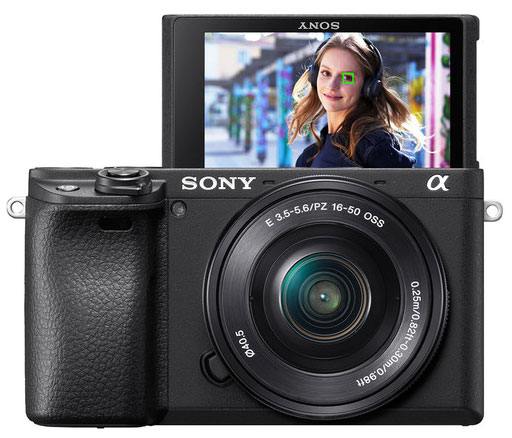
Sony A6400 is the best camera for wedding photography and video, with Sony A6400 u get a class-leading AF system, weather-sealed body, and support of a massive amount of third-party lenses.
For Wedding photographers and cinematographers the Sony A6400 is the best. For independent content creators, we already have cameras like Sony ZV-E10. The A6400 still image quality is very good, as well as the 4K video, which doesn’t have any recording limit, and the best part is the range of available lenses for the APS-C E-Mount. If you are a wedding photographer you can have lenses like Tamron 17-70mm F2.8 RXD Lens. One of the best candid lenses for APS-C cameras.
What people are saying after using Nikon for more than a month
This camera is outstanding. Even coming into 2023, it still holds its own against other cameras that cost 2-3 times the price. I purchased this camera along with a Sigma 56 mm lens, and together the two produce amazing 4k content. This was a great purchase.
Sony A6400 at amazon.com
Sony A6400 Pros and Cons
| Pros |
Cons |
- Compact and lightweight
- Quick, accurate autofocus.
- Selfie LCD and EVF
- Good value
- 4K video without recording limit.
|
- No in-body image stabilization
- Single UHS I SD card slot
|
By admin, on May 29th, 2023
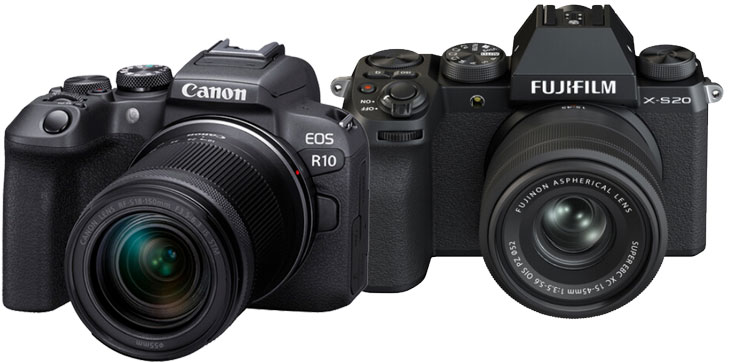
Let’s compare the body design of both cameras. Both are very well built and made for professional shooters with a very deep hand grip and EVF. They are paired up with a variable-angle display screen to give you compositional freedom. Whether you are a photographer or a content creator, you will love the camera’s design.
1. EXTERNAL FAN
The additional advantage we have with the Fuji X-S20 camera is the ability to add an external fan in case of overheating. The external fan will lower the temperature and allow you to record more than double the available recording time.
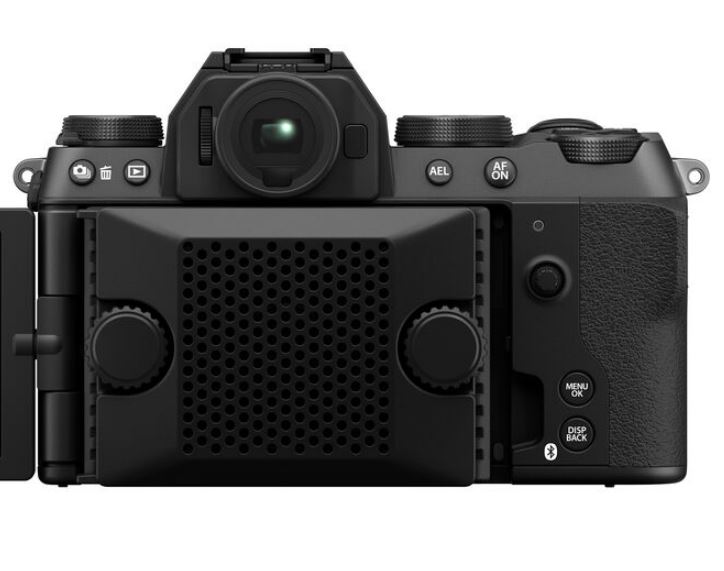 With the Fuji X-S20 camera, we are getting dual 3.5 mm ports; one is for headphones and the other is for a microphone. The microphone port can also be used as a remote shutter port. With the Fuji X-S20 camera, we are getting dual 3.5 mm ports; one is for headphones and the other is for a microphone. The microphone port can also be used as a remote shutter port.
2. EXTENDED BATTERY LIFE
We should discuss this in the design part. We have a larger battery in the Fuji X-S20 camera. The battery allows you to capture approximately 700-800 Liveview shots in a single charge, which is double when compared to the battery life of the Canon R10 camera.
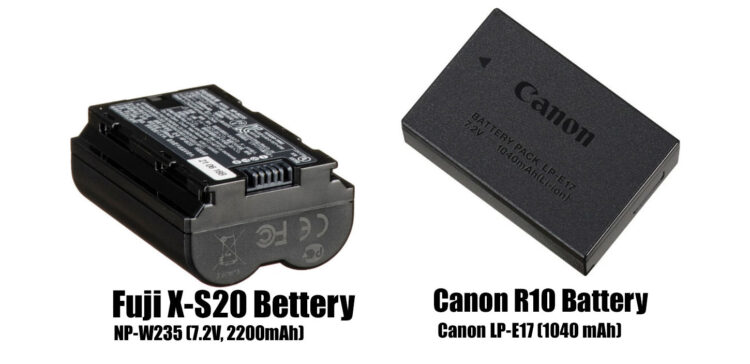
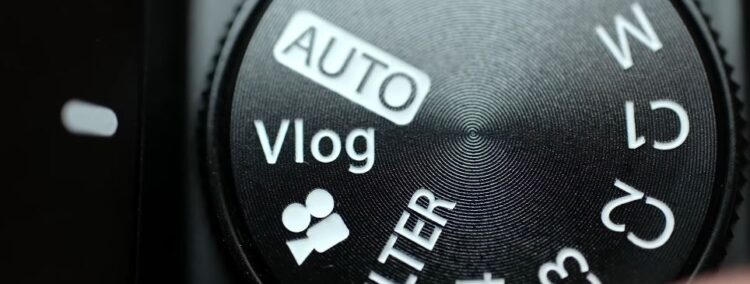
3. VLOG MODE
In vlog mode, we have a dedicated vlog mode in the camera. When you switch the mode dial button to vlog, a new content creator menu pops up. In the content creator menu, you will see 6 different blocks with different modes, including product showcase mode and face tracking priority mode made only for content creators. No content creator or cinematic menu is present in Canon R10.

Let’s talk about the internal core specification of the camera
4. SENSOR
Sensor: The Fujifilm X-S20 camera features Fuji’s popular 26-megapixel sensor. The sensor is a BSI CMOS sensor, not an FSI CMOS sensor like that of Canon R10. So while having a BSI CMOS sensor, we do expect better low-light performance with the Fujifilm X-S20 camera.
Let’s have a look at a quick high ISO test between the two. A sample captured at ISO 25600 of a Canon R10 and Fuji X-S20 camera clearly shows the advantage of having a BSI CMOS sensor while capturing images in low light.
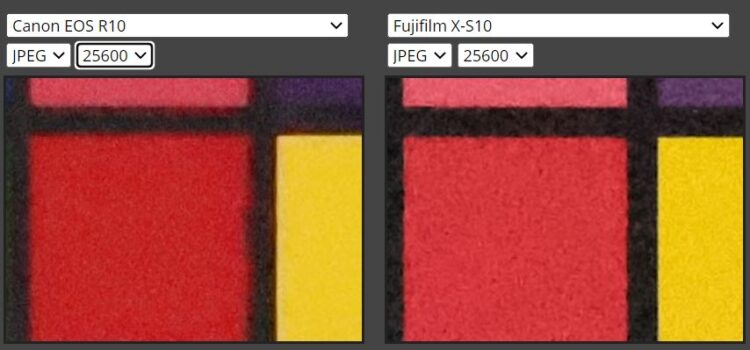
From the high ISO test, it is very clear that Canon is not able to preserve the color details at high ISO range when compared to a Fuji sensor.
The next is autofocusing performance. Both Fuji and Canon are using their latest generation of image processors
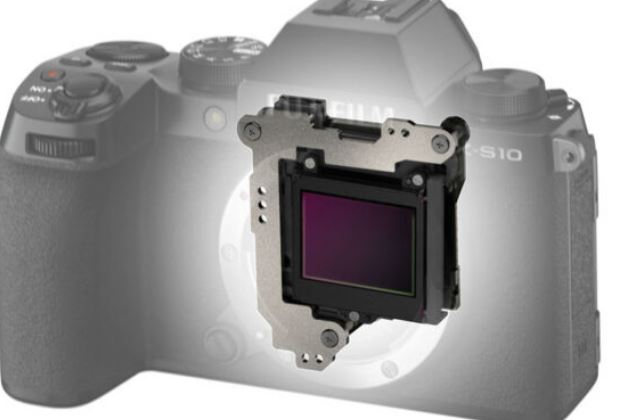
5. IMAGE STABILIZATION
In the Fujifilm X-S20 camera, we are getting sensor-shift image stabilization system up to seven stops. Not only that, for the first time in a Fuji camera, we have a dedicated menu to adjust the image stabilization setting according to our needs. No sensor-shift image stabilization system is present in the Canon R10 camera
6. BURST MODE
The next visible difference between these two cameras is the burst speed or the continuous shooting speed. With the Canon R10 camera and its 24-megapixel resolution, you can achieve a burst speed of up to 24 frames per second. With the Fujifilm X-S20 camera, the maximum burst speed available is 30 frames per second with crop and without crop at full resolution up to 20 frames per second.
While using the mechanical shutter, the Canon R10 allows you to capture 12 frames per second and the Fuji X-S20 camera allows you to capture 8 frames per second.
Buffer memory of Fuji X-S20 camera is more compared to Canon R10, its clearly visible in the table below.
| |
Fuji X-S20 |
Canon R10 |
| 10 FPS |
1000+ JPG — 341 RAW |
|
| 15 FPS |
|
460 JPG — 29 RAW |
| 20 FPS |
256 JPG — 79 RAW |
|
| 23 FPS |
|
70 JPG — 21 RAW |
| 30 FPS (1.25x crop) |
407 JPG — 88 RAW |
|
7. AUTO-FOCUSING SYSTEM
Canon R10 arrives with its popular second-generation dual pixel CMOS autofocusing sensor and more than 5000 autofocusing points fabricated inside the sensor. Furthermore, the camera uses 3700 DPAF points while recording video. To simplify it for its users, Canon grouped the points into 651 autofocusing zones.
Now, the Fujifilm X-S20 camera may not be able to match the number of DPAF points, but for the first time, it uses the most advanced artificial intelligence tracking system available inside Fuji. Fujifilm engineers directly used the artificial intelligence AI algorithm of the Fuji X-H2S camera in the Fuji X-S20. This AI enhances the overall performance of the camera and now the camera is even able to track moving drones and insects without an issue. The X-S20 now also features product showcase mode and face AF tracking priority mode.
So more or less both of these cameras have their own advantages and disadvantages when it comes to autofocusing performance.
8. VIDEO
The Fujifilm X-S20 camera is able to shoot 6.2K open gate in 3:2 format at the rate of 30 frames per second. So that’s the maximum resolution available in the Fujifilm X-S20. Now when you want to record in a standard format, that is in 16:9, the resolution drops to 5.2K. So that’s the maximum standard resolution available inside the Fujifilm X-S20 camera. None of these high-resolution modes are available in Canon R10.
The Fuji X-S20 camera is able to record uncropped 4K 60p video as well as full HD videos at the rate of 240 frames per second. Canon R10 fails to impress us as we have to face a 1.6x crop while recording 4K 60 frames of video. At the same time, only a 120 frames per second option is available at full HD format inside Canon R10.
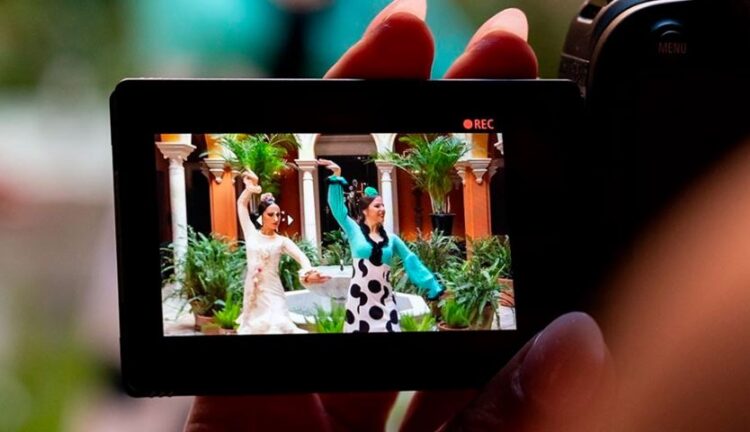
And the biggest difference that will shock you is that no C-Log format is available. Yes, you are able to record 10-bit only in HDR PQ mode in Canon R10, whereas in the Fujifilm X-S20 cameras F-Log and F-Log 2 are both available. In F-Log 2 curve, you are able to extract 13+ stops of dynamic range and at the same time, a 12-bit raw output is available via the HDMI port.

For content creators, we have a dedicated content creator menu and again dedicated autofocusing modes. Not only that but the advanced cinematography and content creation are being backed by the sensor-shift image stabilization of the camera.
For super cinematographers, content creators, and wedding videographers, the Fuji X-S20 camera is the best choice.
So for cinematographers containing creators and wedding video graphs for Fuji x as 20 cameras is the best choice

9. LENSES
Fujifilm X-mount is an open mount and we have a huge range of lenses available and more are coming. At the same time, the Canon RF mount is a locked mount and has a very limited range of lenses available for the APS-C range. If you move towards the DSLR lenses, then you have to be very careful while picking them up since the lenses with STM motors are fully compatible and the older lenses with USM motors will create noise, and not all of them are optimized for dual pixel CMOS autofocusing sensor
10. PRICE DIFFERENCE
We do have a good price difference between these two cameras. If you are on a very tight budget and not able to spend extra on lenses, then you may stay with the Canon R10 camera. But if your budget allows, I highly recommend you to get the Fujifilm X-S20
Fuji Film X-S20 – Camera $1299 [Body Only B&H] [Amazon.com] | 15-45mm Lens $1399 [B&H Store] [Amazon.com]
Canon R10 – Camera body $879 [B&H Store] [Amazon.com] | 18-45mm Lens [B&H Store] [Amazon.com]
By admin, on September 27th, 2022
A perfect camera designation has changed a lot after the arrival of the Mirrorless era. The camera makers become more aggressive and now a perfect camera is considered to be that has not only Top notch core specifications but also a versatile lens ECO system.
There is a lot of confusion among users that which one of the best mirrorless cameras to buy in the year 2022 or 2023. Since there are a lot of cameras out there with almost similar core specifications. So, we have written this article in such a way to clear all your confusion related to the cameras you want to buy.
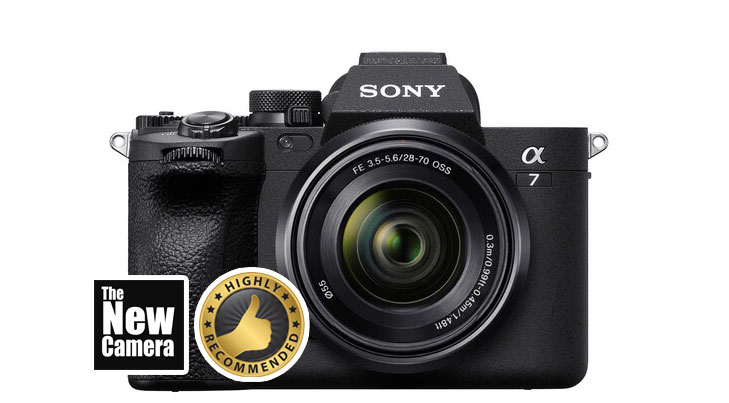
1. Sony A74 – Best Hybrid Mirrorless camera Under $3000
Sony A7 4 is an excellent camera. When the camera was announced it was having a serve overheating issue. We have quickly figured out that with the use of fast cards the camera overheating can be prevented. So if anyone here is interested in getting Sony A7 4 camera and concerned over its overheating issue then you don’t have to worry you have to buy just these cards to prevent the overheating of your camera.
Specs-wise the Sony A74 camera is a class-leading camera with a 33 MP BSI CMOS sensor. The camera captures more detail compared to Nikon Z6 marks 2 camera or the canon R6 camera which roughly falls in the same price range.
And one of the most important things is the camera features an entirely newly developed touch interface system, so it has now become very easy to use even for new users. And the introduction of S- cinetone picture profile in the camera for video and still use, you can have a Canon-like color tone in your video and jpegs.
Apart from these still specifications, the video core specification of the camera is also highly impressive. The camera uses the entire sensor area to generate high-quality 4K 24, 30, or 60 FPS videos. No limit, Longer than one hour of continuous 4K 60p 10-bit 4:2:2 recording and bitrates up to 600 Mb/s.
The lens ecosystem is also very rich and you can have a variety of lenses based on your own requirements.
What Canon users say about Sony A7 iV
Sony A7IV after regular use of my Canon DSLRs. The A7IV is portable, lightweight and versatile, allowing me to move from taking stunning photos to recording video content for my clients which range from fashion to hospitality. Moving from photo to video shooting is smooth and does not break my workflow. I get to focus on capturing the moments. The kit is fantastic as-is, but I also purchased a 50mm 1.8 lens which I’ve been accustomed to shooting with. All in all, I would highly recommend the purchase if you’re in the market for a mirrorless camera.
What Nikon users say About Sony A7 IV
Coming from Nikon after 18 years it’s been a hard learning curve but worth every penny! Yes, the kit lens people say is a joke but it is what it is.I have made it work for studio work and am happy. Not a prime but it works. The camera is something else! Studio work, outdoors, birds, and sports it has done what I want and lots better. I am coming from a long line of Nikon cameras with the latest being the d750 and d850.
Top alternatives Sony AIV
|
Canon R6
Get Canon R6 instead of A7 IV only when
- You are a sports shooter
- You need a far better body IS
- You already have Canon Lenses
|
Nikon Z6 Mark II
Get Nikon Z6 Mark II instead of A7 IV only when
- You need a budget Fullframe setup
|
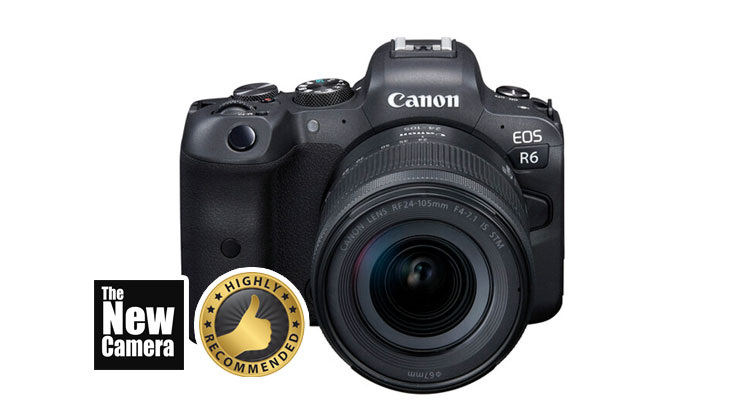
2. Canon R6 – Best Canon full-frame camera Under $3000
Canon R6 camera features a continuous shooting speed of 20 frames per second and in a single burst, you can save up to 1000 frames of Jpeg or 240 raw files which is more than enough for a sports shooter. At the same time to support handheld shooting the camera features 8 stops of IBIS support. The Canon R6 camera also features 1000+ AF zones so the tracking of the camera is exceptionally well. If we combine all the above features, then for sure Canon R6 is a perfect companion for shooting sports and wildlife photography.
Canon R6 is an excellent camera in its price range (Under $3000 with kit). Although sensor resolution is limited to 20 megapixels and the sensor is also a conventional CMOS sensor, not even a BSI. That’s why many professional photographers who have been using Canon for decades are hesitating to get this camera at this price point.
At the same time, the Canon EOS R5 camera is costly and Canon EOS R camera is completely outdated, so the only option we have under the $3000 price range is the Canon R6 right now.
Being said that Canon is still the best option for Sports shooters and wildlife photographers.
User feedback – Sherko
The low light capabilities of this camera is just out of this world. I am getting perfectly usable photos at 8000ISO!!!!!!
User feeback- Tou – Nikon Z6 Mark II user tries the Canon R6
I’ve had the Nikon z5 for over a year and half and it was time to upgrade as I needed better video and AF. I thought about the Nikon Z6ii, but having to carry two different cards and still subpar auto focus, I decided look into the R6. Although it is much pricier than the Nz6ii, so far I am loving it. As of this review, I’ve had it for 3 days and it is amazing. Love the AF, the IBIS for video and low light performance. Could not be happier with this purchase.
Top Alternatives of Canon R6
If we talk about budget alternatives then we have two options
|
Nikon Z6 Mark II
For wedding shooters, Nikon Z6 Mark II is a better option when paired with Nikkor 28-75mm F2.8 Lens |
Canon R7
Canon R7 is an excellent option against the Canon R6 camera if you are a sports shooter or a wildlife photographer. You will have the crop advantage as well as Canon R3 AF tracking system inside the Canon R7. |
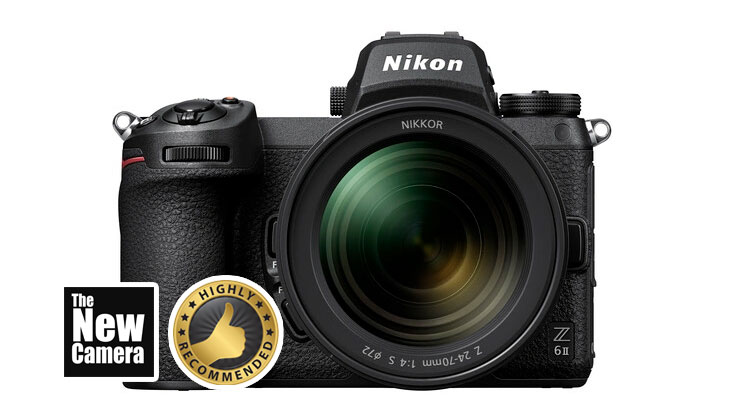
3. Nikon Z6 Mark II – Best Nikon full-frame camera Under $2500
Nikon Z6 mark II is an excellent camera for wedding photographers and wedding cinematographers. Either you can pick this camera with 24-70 F4 Lens which is also available as the kit or you can also add some extra bucks to purchase the amazing candid lens, the Nikkor 28 to 75 f2.8.
Pictures are sharp and clear with amazingly good pics even at 6400 ISO. Even the 27-7 F4 kit lens is surprisingly sharp. The 5 axis IS is a welcome addition. The camera is a perfect camera and its price range and no one can replace the Z6 mark 2 camera with its features
Nikon Z6 Mark II camera is a perfect camera for those who are looking for a perfect full-frame solution under budget at the same time the Z-Mount is almost open we are having lenses from Tamron as well as Viltrox and in near future, we do expect to get more options from third party lens maker’s.
User feedback – Jason – Nikon Z6 Mark II with 24-70 F4 Lens
The camera produces great images. Built ruggedly and takes everything a pro can throw at it. The 5 axis IS is a welcome addition. While not having the opportunity (yet) to fully test the kens, initial impressions are that in a very lightweight body, the lens produces sharp and contrasty images with nice bokeh.
Top Alternatives of Nikon Z6 Mark II
|
Sony A7C
Sony A7C is the only alternative we have against the Nikon Z6 Mark II camera. If you don’t want to buy a Nikon camera (have any personal brand issues) then you can go with Sony A7C |
|
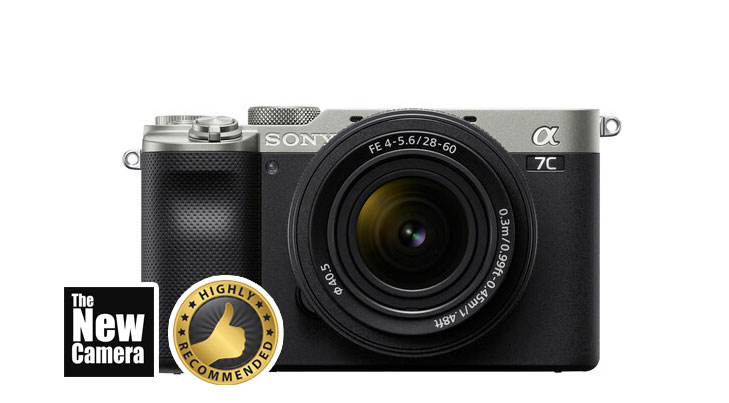
4. Sony A7C – Best Sony Fullframe under $2000
Sony started a new line of consumer cinema cameras with the Sony A7C, you can record high-quality 4K videos for your YouTube channel even if you are a beginner then this camera is useful to you. It’s very light, film amazing at night and I like its retro style looking.
Can photographers buy the A7C? – Yes, if you were interested in the Sony A7 III camera and at the same time, u don’t have the budget of the Sony A74. Then the best option right now is to go with the Sony A7C.
The only issue I have faced while using the Sony A7C camera is its old user interface. otherwise, it’s an excellent budget full-frame mirrorless camera from Sony.
Top Alternatives of Sony A7C
|
Nikon Z6 Mark II
If you want to have more manual control in your camera with a fullframe sensor the Nikon Z6 Mark II is an excellent option in the same budget range. |
|
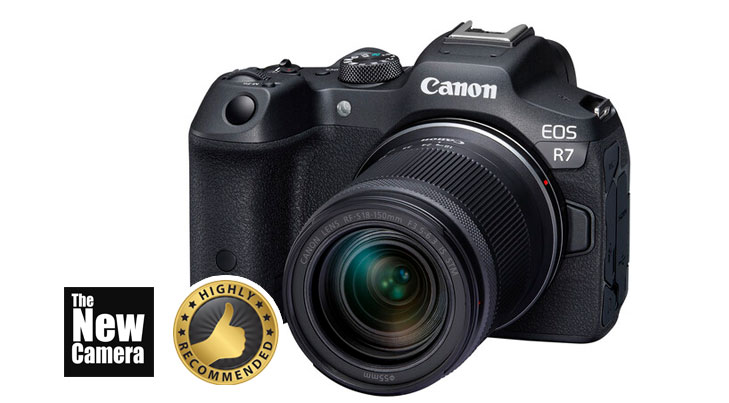
5. Canon EOS R7 – The Best Pro Under $2000 Mirrorless camera for Wildlife and Bird Photography
The next camera on our list is Canon R7. The camera features a 32.5 megapixels APS-C CMOS sensor and digic x image processor.. With the help of a fast image processor, you can capture 30FPS per second @ full resolution. At the same time, the mechanical shutter support is available up to 15 frames per second.
Canon R7 vs Sony A7 III
The camera is capable to record 4K 24 and 30FPS oversample video by reading out the entire 32.5 MP sensor. You are also getting Canon Log profiles and the ability to record 10-bit videos internally with the Canon EOS r7 camera
Can you sir 7 camera is an excellent camera for those work in control light environment And highly recommended for those who are interested in sports and wildlife photography
Alternatives of Canon EOS R7
|
Sony A7C
When you want to shoot the video or shoot still images @ same budget but need a better low -light performance and open LENS ECO system. |
|
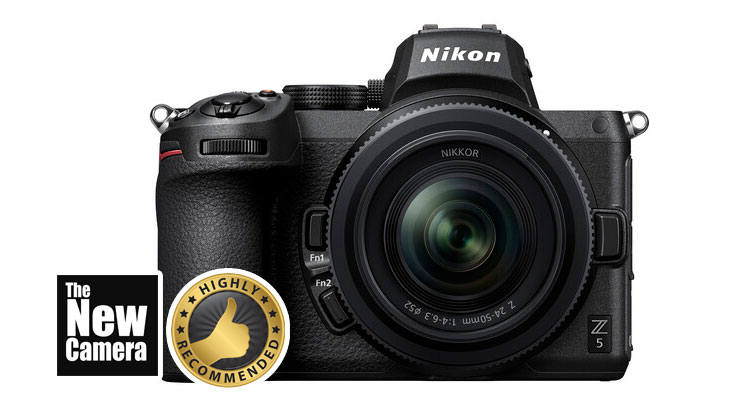
6. Best Fullframe Camera under $1500
Nikon Z5 is a budget full-frame camera that features a 24-megapixel FX sensor paired with expeed 6 image processor and you will also get 5 axis image stabilization system with the camera. It’s an excellent camera to capture images with a high amount of detail and amazing dynamic range. The low light performance of the sensor is also very good compared to the APS-C cameras we have in the same price range.
If you are a photographer and looking for a quality output then under $1500 Z5 is the best option.
The downside of the Nikon Z5 camera is the video part, the camera is able to record full HD videos without any issues but in 4K you have to face an excessive crop.
At the same time don’t expect autofocus tracking performance similar to Canon or sony. If you love to have better autofocus tracking performance in Nikon then either you can go with the Nikon z50 or Nikon Z6 mark 2. But, being said that, under $1500 price range the Nikon Z5 is still an excellent option for photographers out there.
Alternative of Nikon Z5
|
Nikon Z50
Nikon Z50 is an excellent alternative to the Nikon Z5 camera since it gives the almost same level of low-light performance that you will get from the Nikon Z5 with improved AF tracking performance. |
|
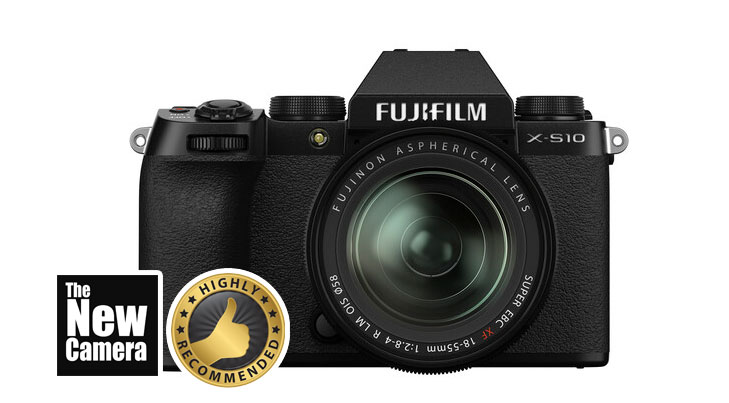
7. Fuji X-S10 for Fuji Lovers – Best Fuji Camera Under $1500
If you love to buy a Fuji camera then Fuji X-S10 is also a good option. With the Fuji X-S10 camera, you’re getting a 26MP BSI CMOS sensor and brust speed up to 30fps. The camera is also able to record you DCI 4k oversampled video recording with IBIS (sensor-shift image stabilization) and in Small, light, great grip, IBIS, same image quality as the X-T4 at a bargain price.. The handgrip is great. The battery life is too short. Overall – The x-s10 is a great camera for photographers as well as vloggers. For an instant video shoot for documentarists, it is great.
At the same time, I have to mention that don’t expect AF performance similar to Sony A6400 or Canon R10, for that level of AF performance in Fuji you have to buy Fuji X-H2S.
Best alternatives
|
Nikon Z50
If you want to have a better low-light performing camera than the Fuji X-S10, then the only option we have after is the Nikon Z50 camera. |
Sony ZV-E10
If you want to get a better vlogging camera, with gyro-based IS, a bit more option for APS-C lenses, and amazing eye tracking performance then go with the Sony ZV-E10. |

8. Canon R10 – The fastest Mirrorless in its class
Canon R10 is also a very good APS-C mirrorless for still and video purposes. The camera pair of 24-megapixel APS-C CMOS sensors with canon’s fastest Digic x image processor.
With the help of both, you are able to grab continuous frames up to 23 FPS with full-time autofocus support, and the R10 camera records video up to 4K 60 FPS and oversamples 4K videos up to 30 FPS
The Canon R10 is one of the first cameras to provide a 10-bit internal recording in the same price range. The only downside of Canon are 10 camera is its low light performance, the camera needs a studio light set up to give the best output possible
Best alternatives
|
Nikon Z50
Nikon Z50 AF tracking isn’t as fast as Canon R10, but you will get better low light performance then the Canon R10 camera which makes Z50 a perfect option for the uncontrolled low-light environment |
Sony ZV-E10
If you want to get a better vlogging camera, with gyro-based IS, a bit more option for APS-C lenses, and amazing eye tracking performance then go with the Sony ZV-E10. |
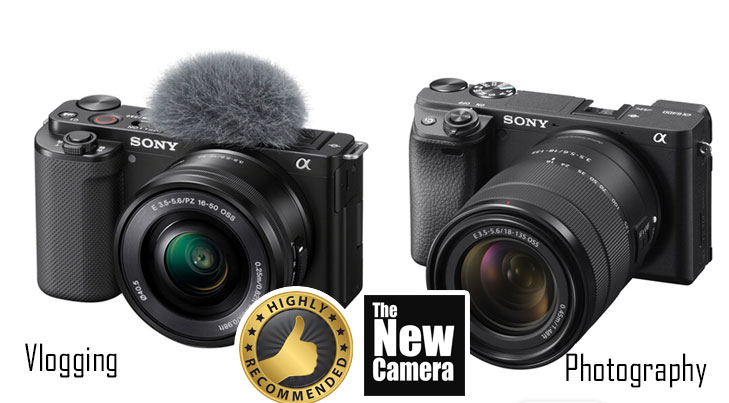
9. Sony ZV-E10 & Sony A6400 – Best Sony’s Under budget
In the 9th place, we have two cameras. If you are into photography and wedding cinematography, then the best option for you is the Sony a6400 camera. The camera features a perfect grip for photographers, a weather-sealed body for durability, and EVF for semi-pro photographers.
And if you want to have the most advanced vlogging camera under budget then undoubtedly the Sony ZV-E10 is the best option right now. The camera features the most advanced set of core specs that a vlogging camera may have in that price range. Excellent face-tracking autofocus for VLOG applications. Has an earphone jack to monitor sound. Outstanding image quality. (Using a 24 MP sensor for 4K creates very sharp images. Sensors are Sony’s strong suit.) It does not overheat.
No alternatives to ZV-E10 in terms of price range and specification.
|
Sony A6400 Alternative
Nikon Z50 is a perfect alternative to the Sony A6400 camera with a weather-sealed body and excellent low light performing sensor. And amazing support of Viltrox lenses. |
|
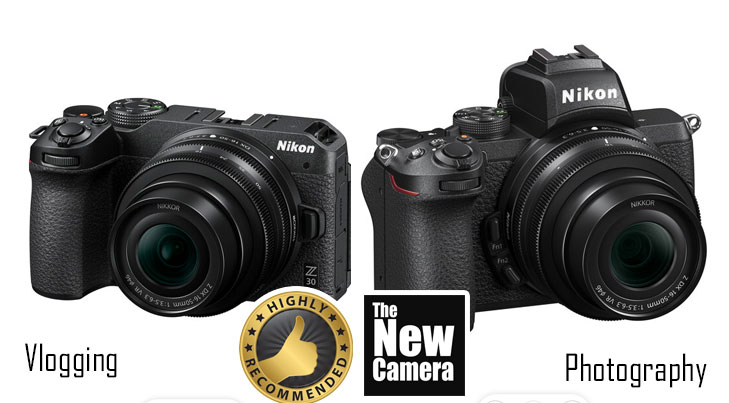
10. Nikon Z50 and Nikon Z30 – The Best budget DUO from Nikon
Nikon z50 is an excellent option for those who are looking perfect camera for uncontrolled light conditions. When you are not in your set or studio and mostly you are interested in Street photography or anywhere when you don’t carry or have professional lights with you the Nikon z50 will outperform all the other cameras of the same price range. If I have to sum up the Z50 in a few words I will say “This a great camera. Light weight and produces amazingly clear shots.”
Nikon Z30 is the same Nikon z50 camera with up-scaled video specifications and without a viewfinder to save the production line cost. If you want to have a perfect low-light vlogging camera then Z30 is the best option under budget. Due to a slightly lower resolution, the rolling shutter effect is also less compared to other competitors.
We have no alternatives for Nikon Z50 at its price range since it’s an excellent lowlight performing camera
|
Nikon Z30 alternative
the only best alternative to the Nikon Z30 is the Sony ZV-E10. |
|
Top 5 Best Wedding Photography Cameras of 2022
Support us – Use or affiliate link Amazon.com | B&H Store for the next purchase u make – it helps us
By admin, on July 20th, 2022
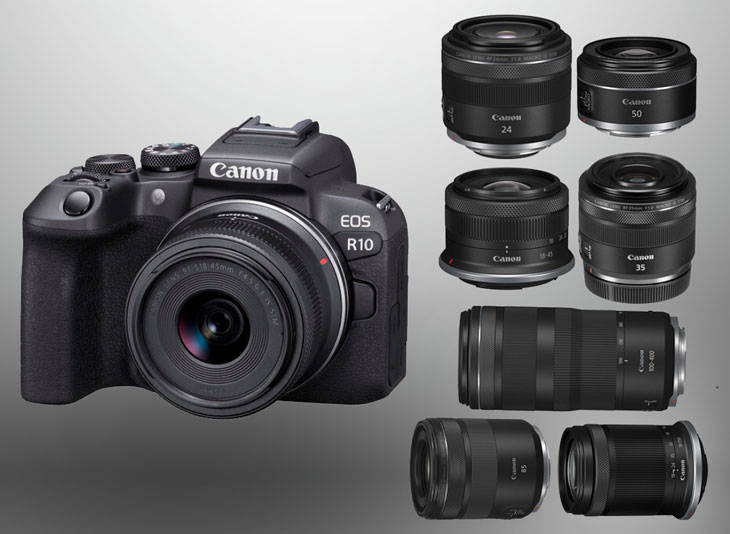
The best lenses for the Canon R10 Camera are here. The camera features redesigned Canon EOS m50 Mark II camera sensor and autofocus algorithm coming straight out of the Canon EOS R 3 camera. The camera features a blazing fast continuous shooting speed of 23 frames per second and with a mechanical shutter, you can shoot up to 15 frames per second. The Still Core specification of the camera is highly impressive as well as the video core specs, they literally allow you to record 10BIT videos internally in the camera card via HFRPQ mode.
In this post, we have selected the best available lenses for the Canon R10 camera. However, you can also use these lenses for the Canon R7 Camera too. We have selected the native RF and RF-S Lenses for the Canon R10 camera. And at the end of the article, we have also added third-party lenses for the Canon R10 camera.
We have also made some comparison which includes Canon R10 vs Nikon Z50 and Canon R10 vs Sony A6400.
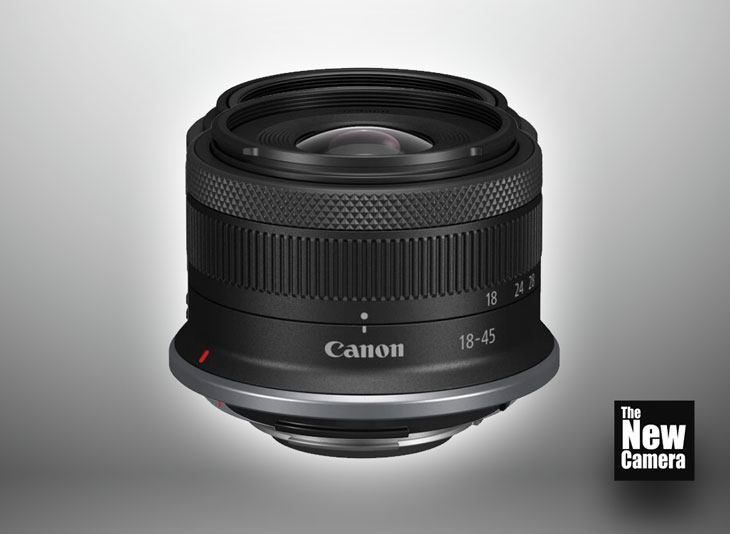
1. The most affordable zoom lens 18-45mm IS STM
The body of the Canon R10 cost $1099 with the 18-45mm kit lens and without the lens, the cost of the camera body is $979. The actual cost of the lens $269 when purchased separately from B&H. You are actually saving more than $149 on the kit lens which is a super deal at the beginning.
I know the kit lens quality is bad, but the 18-45mm IS STM Lens from Canon is really versatile. The focal length you are getting is perfect for landscape, nature, and family-friends photography.
You can also click some portraits when used at 50mm. The actual advantage is the price factor and the compactness. And at this price ur also get the Image stabilization (OIS) and STM motors which is useful for both photography and videography.
Image stabilization in the 18-45mm Lens works very effectively. As we know the Canon R10 camera doesn’t have a built-in sensor-shift image stabilization system, so this lens will help you with its Optical Image stabilization feature. up to 4 stops of shake correction or up to 6 stops of Coordinated IS with a compatible camera body
The RF-S18-45mm f/4.5-6.3 IS STM has a Center Focus Macro function that captures close-up images with up to 0.26x magnification at 45mm (MF) Achieve up to 0.16x magnification at 45mm focal length with autofocus. When you are using the lens at Manual Focus mode At 35mm focal length it gives a maximum magnification of 0.59x.
.The Lens also features Canon STM Motor, which is extremely helpful while shooting videos, the STM motors generate minimal noise.
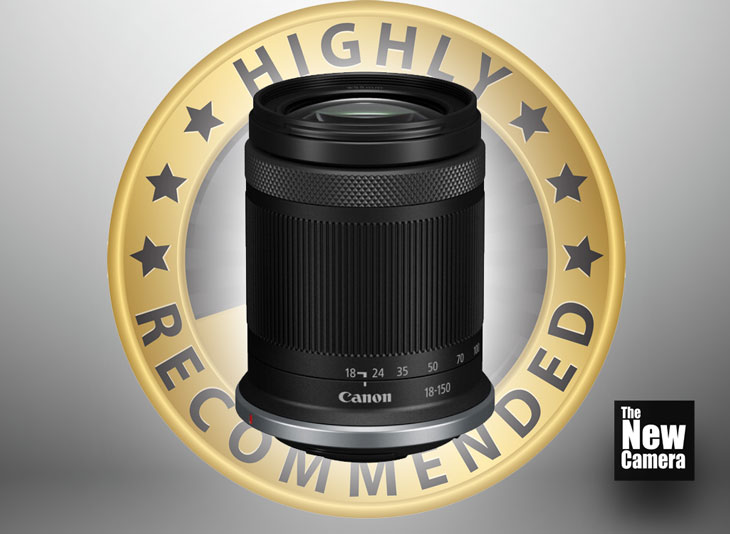
2. Canon RF 18-150mm Lens
The Canon has recently announced the 8.3x APS-C zoom Lens for Canon R10 that packs in a useful 29-240mm (35mm equiv.) focal length range. It’s ideal for travel, wedding photography, landscapes, garden wildlife, and sports.
This lens is an all-in-one lens for the Canon R10 camera. Perfect those who don’t want to change the lens every time need an all-in-one solution. The Lens also acts as a coverage lens when you are into wedding photography and helps you a lot when u are in travel, covers a wide range of 18mm to tele-end 150mm.
The lens features an STM motor, steeping drive motors are fast as well as silent. Perfect for recording videos and shooting still images too. The OIS in this lens is highly effective and works up to 4.5 Stops, or up to 6.5 stops with Coordinated IS when paired with a compatible camera. Making it a perfect choice for shooting sharp images in low light.
The price of this lens is $499 (B&H Store and Amazon.com) You can use this lens as a default lens for your Canon R10 camera.
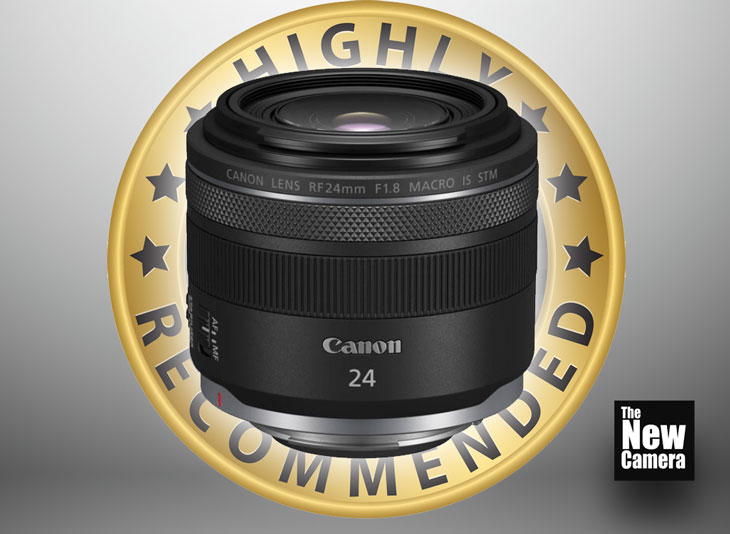
3. Canon RF 24mm F1.8 Macro IS STM Lens
I would say the 24mm F1.8 Macro STM lens is the most usable prime lens for a photographer with an APS-C Sensor based body like Canon R10. The eqv focal length of this lens is 38mm which is near the standard focal length of 35mm. The wide angle is ideal for landscape and street photography. This 24mm lens can be used for shooting family and friends’ portraits in a home in a low-light environment. Also perfect for capturing macro images due to its 1:2 magnification ratio and close-up shooting distance of 5.5 inches.
Perfect lens for YouTubers: You can also use this lens for your office and room vlogs, also perfect for food photography or vlogs with this lens. You have to just maintain 3 to 5 feet distance from your camera/rest your camera on a tripod, make a 3 to 5 feet distance from the camera and start making your online content with excellent sharpness and creamy bokeh in the background.
The 24mm Lens also features OIS (Optical image stabilization), for the first time I have seen Canon giving us OIS features in Prime lenses like 24mm. The OIS is effective up to 5 stops, or 6.5 stops with coordinated IS, to better enable working handheld in low-light conditions and with slower shutter speeds. Whether you are creating videos with the lens or shooting still images the OIS help all the time.
The lens is available at $499 (B&H Store and Amazon.com) You will feel the price is high. But also think twice that it’s a Fullframe lens and will remain compatible with your camera even if you upgrade your camera to full frame. And despite being a 24mm Prime lens, the lens also features OIS and macro Capability, none of such features are available even in competitors’ lenses.
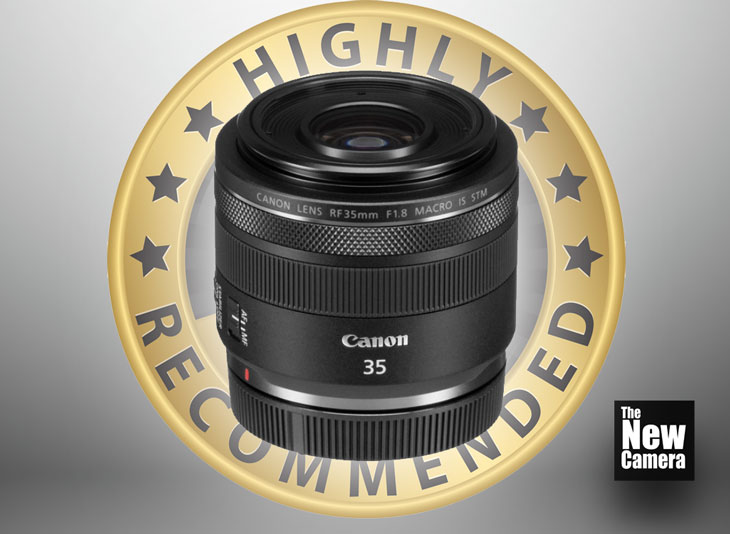
4. Canon RF 35mm F1.8 Macro IS STM
Perfect for professional-quality portraits with a Canon R10 camera. The Canon RF 35mm F1.8 when paired with Canon R10 gives you an equivalent focal length of 50mm Lens in full-frame format. So it actually will act as a 50mm F1.8 with optical image stabilization and macro capability.
The size of this lens is slightly larger than the 24mm F1.8, It measures 74.4 x 62.8 mm and weighs 305g. However, this is still relatively light and compact. The lens pairs very comfortably with the canon R10 camera and has a sleek look and feel. There is a focus switch on the side of the lens, the lens does support full-time manual focus. That is, you can manually focus the lens by adjusting the focus ring even when the camera is set to autofocus.
The 35mm Lens allows you to set the MAX aperture to F1.8, which enables the lens to capture amazing low-light images in any conditions and generate pleasant, creamy bokeh-filled backgrounds. The lens features Super Spectra coating that has been applied to individual elements to reduce the ghosting and flare for greater contrast and color neutrality when working in strong lighting conditions.
$499 (Amazon.com | B&H Store) is the price of a 35mm F1.8 IS STM Macro lens, this is a very reasonable price lens if you look at its features. The lens is a Fullframe lens and features Macro capability as well as optical image stabilization. We highly recommend this lens for the Canon R10 camera.

5. Canon RF 50mm F1.8 STM Lens
If you are into portrait photography and looking for an affordable option the Canon RF50mm F1.8 Lens is best for you. The RF 50mm lens is equivalent to 85mm when paired with a Crop sensor camera like Canon R10.
The telephoto prime lens measures 69 x 40 mm and weighs 160 g. This makes it the lightest lens on our list, , balancing well with the weight of the camera. To suppresses spherical aberrations Canon has introduced One precision-molded (PMo) aspherical element inside this lens, it also upscaled the sharpness and accurate subject rendering.
The overall image quality is fantastic. You’ll love how easy it is to snap incredibly sharp, beautiful photos using this lens, and your subjects will love it even more. Although the lens has a limited Macro capability of 50cm, so if you want a better macro performing lens you have to buy the other two primes (24mm and 35mm) mentioned above in the list.
With a price tag of $199 (B&H Store | amazon.com) Canon RF 50mm, F1.8 STM Lens is the most affordable prime lens in RF lineup. The reason behind that is the lens doesn’t have the OIS like the other prime lenses as well as macro capability.
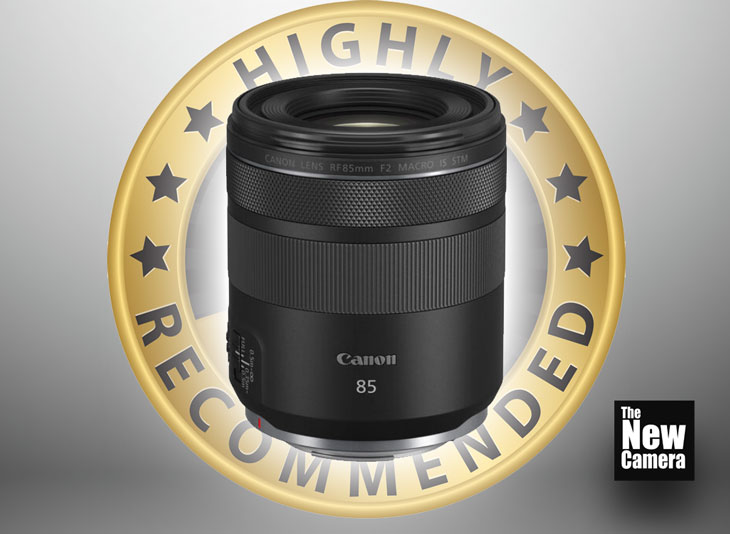
6. Canon 85mm F2 IS STM Macro
Canon 85mm F2 Macro Lens features optical image stabilization as well as a stepping drive motor. The equivalent focal length of 85mm lens on the Canon R10 body will be 136mm. It reminds me of Canon’s popular 100mm F2.8 Macro Lens. The lens can be used effectively when you want to capture wildlife beauty without disturbing them. 85mm (136mm on R10) will allow you to work from a distance and also Optical Image stabilization within. So, you can also take some amazing macro shots or portraits of models handheld.
The telephoto prime lens measures 78 x 90.5 mm and weighs 500 g. This makes it the largest and the heaviest lens on our list, Configurable Control Ring can be used to adjust a variety of exposure settings, including aperture, ISO, and exposure compensation. The rounded nine-blade diaphragm contributes to a pleasing bokeh quality.
The lens creates creamy bokeh at F2 and is perfect for portraits, I have used this lens with a Canon R5 camera and at F3.5 to 5.6 the lens produces razor-sharp images with an exceptional amount of details resolved through the sensor. With its macro capability, the lens is able to do 1:2 maximum magnification along with a minimum focusing distance of 1.15. And the Configurable Control Ring on this lens can be used to adjust a variety of exposure settings, including aperture, ISO, and exposure compensation.
The price tag $549 (B&H Store | amazon.com) price makes this lens one of the most costly prime lenses on our list. although with Optical image stabilization, Macro capability, Steeping drive motor, and rounded nine-blade diaphragm make this lens the perfect choice for professional photographers.

7. Canon RF 100-400mm f/5.6-8 USM
Prime lenses do give the best quality possible since they have minimal moving lens elements inside them optimized for best performance. However, zoom lenses like the 100-400 are also a worthwhile investment.
With prime lenses, if you want to have an optical crop you have to physically move toward your subject. This isn’t always possible depending on what or where you’re shooting. So, we have lenses like the 100-400mm (equivalent focal length 160mm – 640mm).
The resolving power of this lens is just amazing even when paired with the Canon R5 camera, lens features Max magnification up to .41X @ 400mm. So, it’s worthwhile to say the lens also has macro capability. To reduce the chromatic aberrations and color fringing throughout the zoom range the lens has One Ultra-Low Dispersion element. The lens features a built-in optical image stabilization system effective up to 4 stops when used with R10, and up to 6 stops of camera shake and Nano USM AF to promote faster focusing performance.
You have to pay $599 (B&H Store | Amazon.com) to get this lens, It may look pricy to you. But the sharpness, OIS, Bokeh, and AF performance are highly impressive. Equivalent to equivalent focal length 160mm – 640mm when used with APS-C body and 100-400 when used with Fullframe.
By admin, on June 8th, 2022
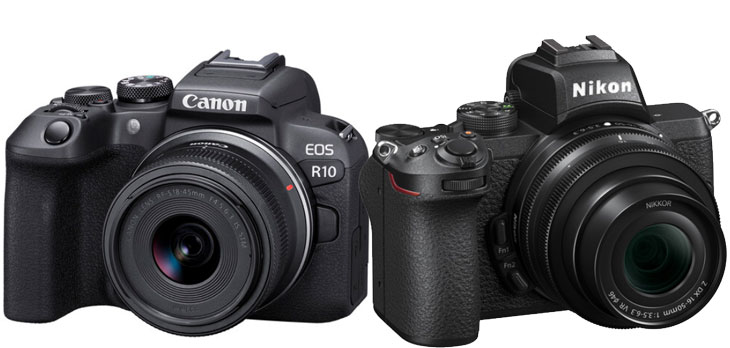
Let’s compare the Canon R10 vs the Nikon Z50 camera. Let’s discuss the major difference between the two. As we know the Canon R10 arrived with a conventional CMOS sensor and due to that Nikon Z50 is able to create space again with its low-light advantage
| Lens Mount |
Canon RF |
Nikon Z |
| Sensor Resolution |
Actual: 25.5 Megapixel
Effective: 24.2 Megapixel |
Actual: 21.51 Megapixel
Effective: 20.9 Megapixel (5568 x 3712) |
| Sensor Type |
22.3 x 14.9 mm (APS-C) CMOS |
23.5 x 15.7 mm (APS-C) CMOS |
| Crop Factor |
1.6x |
1.5x |
| Image Stabilization |
Digital (Video Only) |
Digital (Video Only) |
| Built-In ND Filter |
None |
None |
| Capture Type |
Stills & Video |
Stills & Video |
Image sensor & Low-light performance
Both sensors are made on conventional CMOS Sensor technology. None of them features a BSI sensor. But if we consider the two most important factors that we have here is
1. Expandable ISO range
2. 12% larger sensor pixel in Nikon Z50
Due to the larger pixel area, the sensor can grab more light compared to Canon R10 Sensor. And hence we do expect despite the refinements Canon has done with the R10 sensor despite keeping the sensor core technology the same. We will see at least 1 stop of improvement in the Nikon Z50 low light performance compared to the Canon R10
Canon R10 Has arrived on the market but
If you are more concerned about the low light performance of the camera then even in 2022, Nikon Z50 is an excellent option for photographers.
If ur having doubts about the AF performance then don’t worry the AF performance of the camera is much improved after the Nikon firmware 2.2 updates. The camera is now able to track animals’ eyes too. The overall AI AF of the camera is also much improved.
Slightly more rich Lens ECO system in Nikon – Right now if we compare the Canon RF mount ECO system vs Nikon Z mount ECO system the Nikon is now a collaboration with Tamron and they have started with 28-75 F2.8. Not only that, Viltrox also has an amazing range of Nikon Primes right now.
Nikon APS-C Viltrox Lenses B&H Store
Yes, we do have rumors about Viltrox lenses coming for RF Mount too, but if someone is planning to buy Nikon Z50 right now, then its more feasible to buy the Nikon Z50 camera only for photography purposes (Like weddings, street, and Portraits)
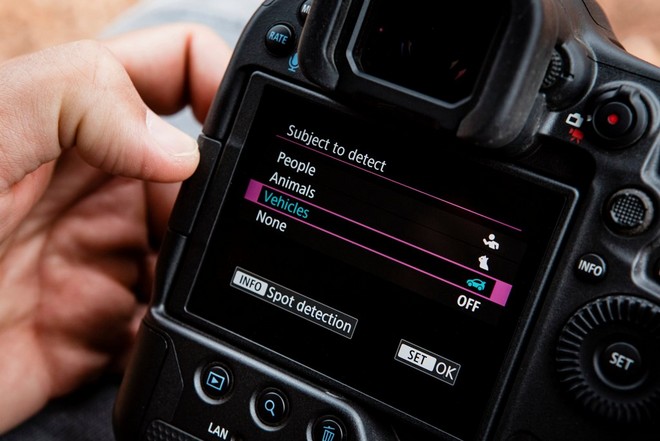
Canon R10 For Sports Shooter. Wildlife Photographers
Canon R10 has just arrived with class-leading AF performance., Canon implemented DPAF gen 2 inside Canon R10 & R7 both. According to Canon’s official press release, the AF performance of the recently announced Canon R10 and Canon R7 cameras is similar to Canon EOS R3 camera. Although we never consider it exactly similar neither they can perform so, due to the lack of a Stacked CMOS sensor like we have in the Canon R3.
651 AF Zones inside Canon R10
Yes, we have 651 AF Zones inside the Canon R10 camera which is comprised of more than 2.9k DPAF points. The AF tracking mode has dedicated 3d subject tracking modes in the Canon R10 camera. Whereas our Nikon Z50 is limited to 205 Hybrid AF points.
Overall, we can say that the AF system of the Nikon Z50 after the arrival of firmware F2.2 has become very usable but the Canon R10 AF system is phenomenal and the best in its class.
| Focus Type |
Auto and Manual Focus |
Auto and Manual Focus |
| Focus Mode |
Continuous-Servo AF, Manual Focus, Single-Servo AF |
Automatic, Continuous-Servo AF, Full-Time Servo, Manual Focus, Single-Servo AF |
| Autofocus Points |
Photo, Video
Phase Detection: 651 AF Zones |
Phase Detection: 209 |
| Autofocus Sensitivity |
-4 to +20 EV |
-2 to +19 EV |
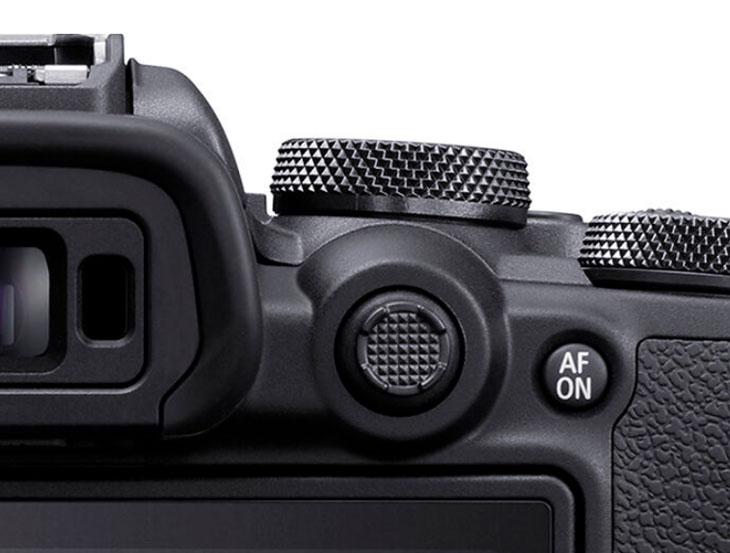
Canon R10 also features a Joystick controller on the rear side of the camera. A helpful tool for professional photographers is now available in the mid-range cameras.
Canon R10 Fastest in its Class
However, being said, if we talk about the stats of the Canon R10 camera, in continuous shooting mode the camera is able to capture 23 Frames @ elec. shutter and 15 FPS with the help of a mechanical shutter. The Buffer depth is also very usable and ur able to capture up to 70 JPEG files @ 23 FPS and up to 450+ files @ 15fps in a single burst.
Either ur shooting at 23 FPS or 15 FPS, the DPAF system is fully active and tracks moving 3d subjects very well.
| Shutter Type |
Electronic Shutter, Mechanical Focal Plane Shutter |
Mechanical Focal Plane Shutter, Electronic Shutter |
| Shutter Speed |
Mechanical Shutter
1/4000 to 30 Seconds
Electronic Shutter
1/4000 to 30 Seconds |
Electronic Front Curtain Shutter
1/4000 to 30 Seconds
Electronic Shutter
1/4000 to 30 Seconds |
| Bulb/Time Mode |
Bulb Mode |
Bulb Mode, Time Mode |
| ISO Sensitivity |
Photo
100 to 32,000 in Manual, Auto Mode (Extended: 100 to 51,200) |
Photo
100 to 51,200 in Auto Mode (Extended: 100 to 204,800)
Video
100 to 25,600 in Auto, Manual Mode |
| Metering Method |
Center-Weighted Average, Evaluative, Partial, Spot |
Center-Weighted Average, Highlight Weighted, Matrix, Spot |
| Exposure Modes |
Aperture Priority, Manual, Program, Shutter Priority |
Aperture Priority, Manual, Program, Shutter Priority |
| Continuous Shooting |
Electronic Shutter
Up to 23 fps at 24.2 MP for up to 70 Frames (JPEG) / 21 Frames (Raw)
Mechanical Shutter
Up to 15 fps at 24.2 MP for up to 460 Frames (JPEG) / 29 Frames (Raw) |
Up to 11 fps at 20.9 MP
Up to 5 fps at 20.9 MP
Up to 4 fps at 20.9 MP
Up to 30 fps at 8 MP |
Best Camera to capture Video
Canon R10 is the best camera to capture High-Quality video, let me explain this. When we are comparing Nikon Z50 and Canon R10 then we will consider both the features and the limitations, let’s discuss the both
Both of them create 4k videos via the oversampling method. Although in Canon R10, we get an option to record 4K 24 / 30 fps video in 10bit format, and in Nikon Z50 we are limited to 8bit. None of them allow us to use Log files from them. And finally, with the Canon R10, we also have an option to record 4K 60p video @ 1.56x crop (although it’s not that usable with the crops factor) but yes we are getting, at least an option that is not available in Nikon Z50 camera.
With Canon HDRPQ mode the Canon R10 is able to record 10Bit videos in H.265 codec @ 170Mbps. So, 10bit in any form is very useful if you know the difference between the 10bit and 8bit video files.
No recording limit, Canon has revoked the recording limit of the recently announced cameras, both the Canon R10 and Canon R7 don’t have any recording limit. But, in the Nikon Z50 camera, we do get a recording time limit of 30min.
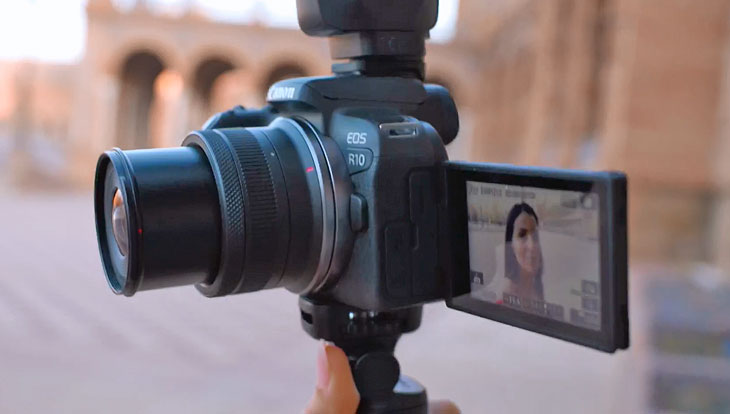
Perfect for Vloggers with a vari-angle display screen.
| Recording Modes |
H.264/MP4 4:2:0 8-Bit
UHD 4K (3840 x 2160) at 23.98p/25p/29.97p/59.94p
Full HD (1920 x 1080) at 23.98p/25p/29.97p/50p/59.94p/100p/119.88p
H.265/MP4 4:2:2 10-Bit
UHD 4K (3840 x 2160) at 23.98p/25p/29.97p/50p/59.94p
Full HD (1920 x 1080) at 23.98p/25p/29.97p/50p/59.94p/100p/119.88p |
MOV/MP4/H.264
UHD 4K (3840 x 2160) at 23.98p/25p/29.97p
Full HD (1920 x 1080) at 23.98p/25p/29.97p/50p/59.94p/100p/119.88p |
| Gamma Curve |
HDR-PQ |
NA |
| Video System |
NTSC/PAL |
NTSC/PAL |
| Limit |
No limit |
30 Min |
| Audio Recording |
MP4: 2-Channel AAC Audio |
AAC Audio
LPCM Audio |
Verdict:
For general purpose photography the Nikon Z50 camera is still usable and you can buy that camera if you want to, the added advantage you will have with the Nikon Z50 camera is the 1 stop better low-light performance. The Z50 AF has improved from the time of announcement and now it has become usable to max extent.
Those Who are Hybrid Shooters (Photo Video both), Contest creators aka YouTubers, Sports shooters, and wildlife photographers, we recommend you to get associated with the Canon R10 camera.
Leatest Price of Canon R10 at B&H Store and Amazon.com | B&H Store
Latest Price of Nikon Z50 B&H | Amazon.com
Also, see – Canon R10 vs Sony ZV-E10
Also, see – Canon R10 vs Sony A6400
See All Comparison & Content Related to Canon R10 Here
Best Lenses for Nikon Z50
More Specs Comparison
| Media/Memory Card Slot |
Single Slot: SD/SDHC/SDXC (UHS-II) |
Single Slot: SD/SDHC/SDXC (UHS-I) |
| Video I/O |
1 x Micro-HDMI Output |
1 x Micro-HDMI Output |
| Audio I/O |
1 x 1/8″ / 3.5 mm TRS Stereo Microphone Output |
1 x 1/8″ / 3.5 mm TRS Stereo Microphone Input |
| Other I/O |
1 x USB Type-C (USB 2.0) Input/Output |
1 x USB Micro-B (USB 3.2 / 3.1 Gen 1) Output |
| Wireless |
2.4 GHz Wi-Fi (802.11b/g)
Bluetooth |
Bluetooth, Wi-Fi |
Monitor
| Size |
3.0″ |
3.2″ |
| Resolution |
1,040,000 Dot |
1,040,000 Dot |
| Display Type |
Free-Angle Tilting Touchscreen LCD |
180° Tilting Touchscreen LCD |
General
| Battery Type |
1 x LP-E17 Rechargeable Lithium-Ion |
1 x EN-EL25 Rechargeable Lithium-Ion, 7.6 VDC, 1120 mAh (Approx. 300 Shots) |
| Tripod Mounting Thread |
1 x 1/4″-20 Female (Bottom) |
1 x 1/4″-20 Female (Bottom) |
| Dimensions (W x H x D) |
4.8 x 3.5 x 3.3″ / 122.5 x 87.8 x 83.4 mm |
4.98 x 3.68 x 2.36″ / 126.5 x 93.5 x 60 mm |
| Weight |
13.5 oz / 382.2 g (Body Only)
15.1 oz / 429.2 g (Body with Battery and Memory) |
13.93 oz / 395 g (Body Only) |
|
KEEP THIS BLOG ALIVE - Support New Camera Buy Canon Lenses, Buy Music CD or Digital Camera at amazon it helps this site, and you do not pay anything extra, it is just a way to help support this site.

|



















 With the Fuji X-S20 camera, we are getting dual 3.5 mm ports; one is for headphones and the other is for a microphone. The microphone port can also be used as a remote shutter port.
With the Fuji X-S20 camera, we are getting dual 3.5 mm ports; one is for headphones and the other is for a microphone. The microphone port can also be used as a remote shutter port.






























